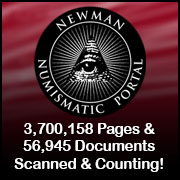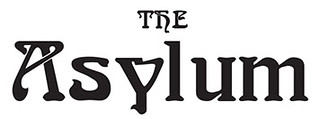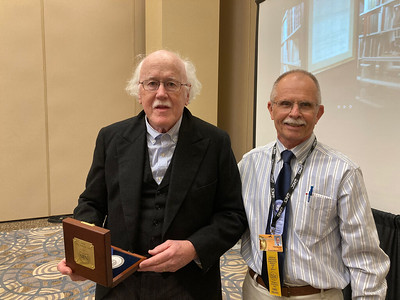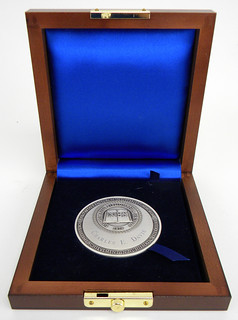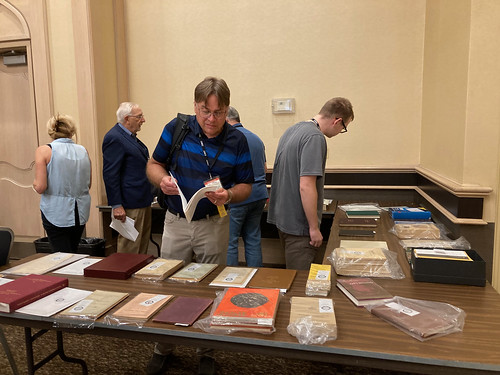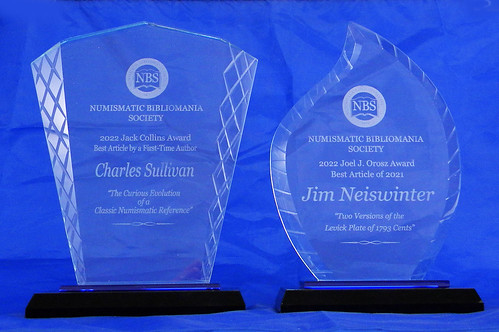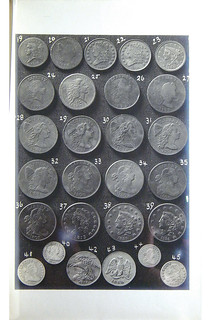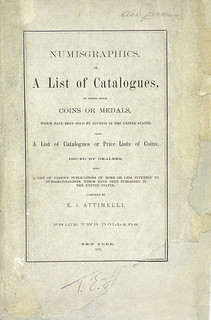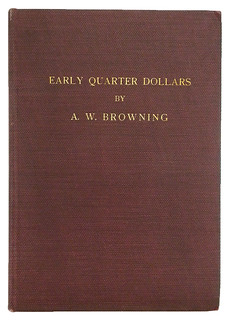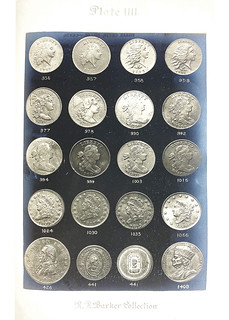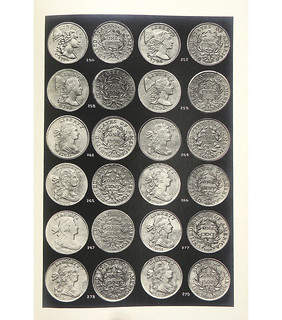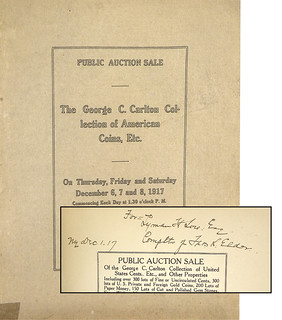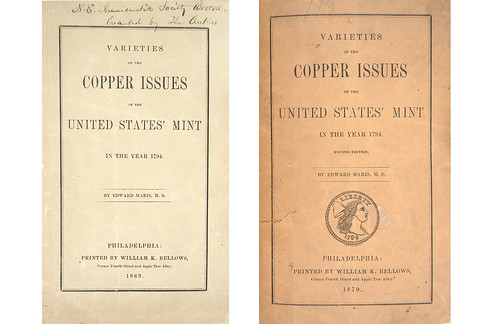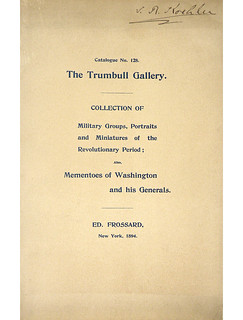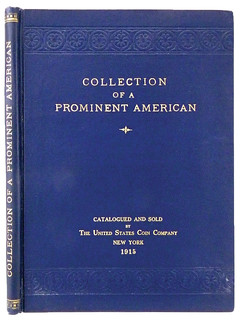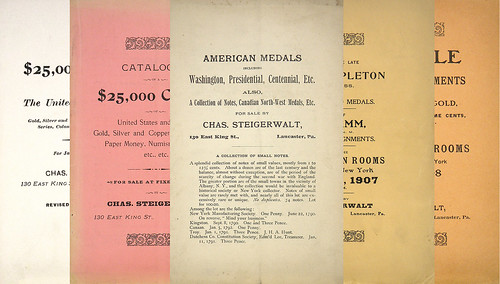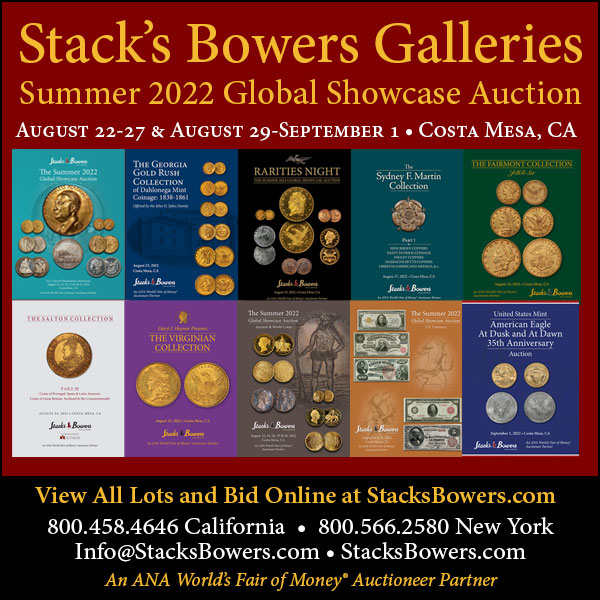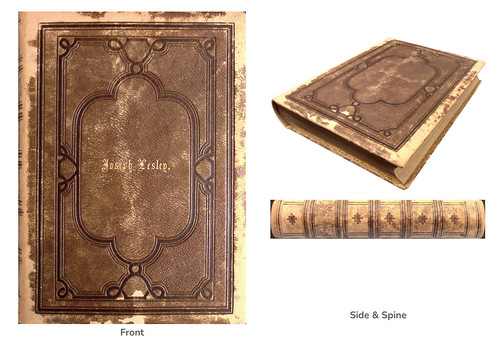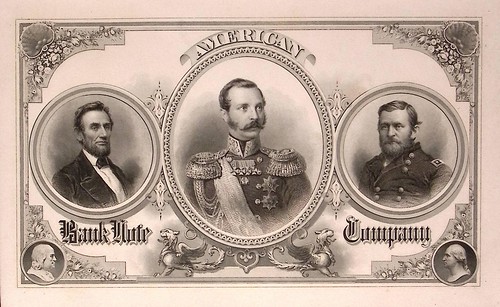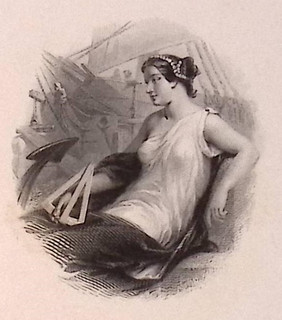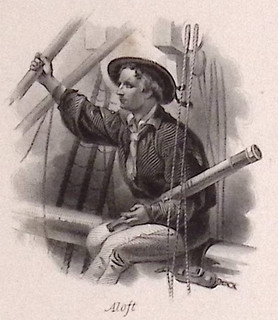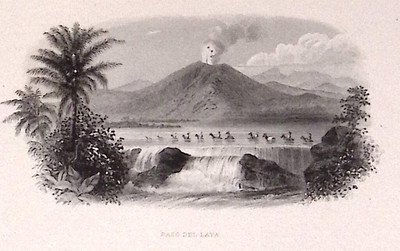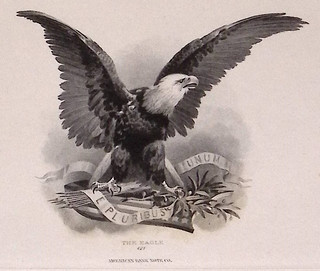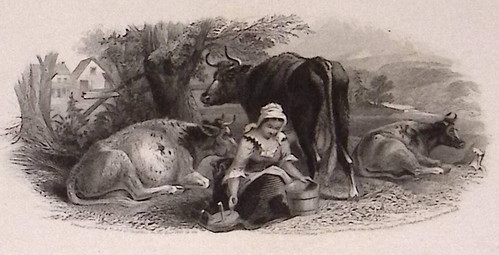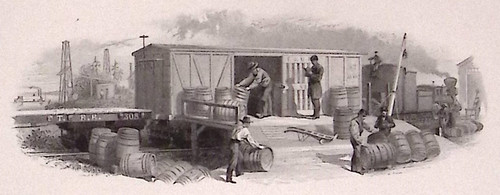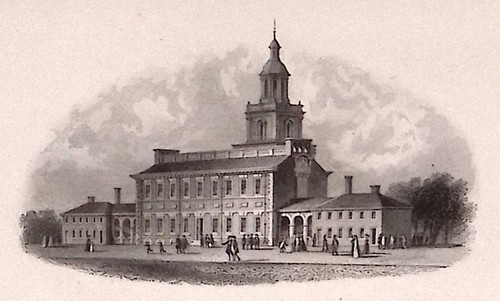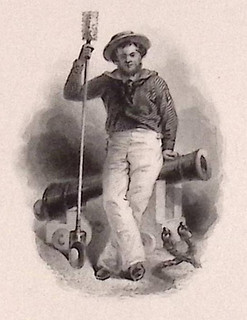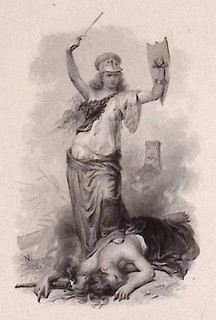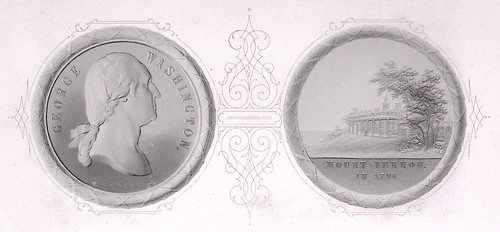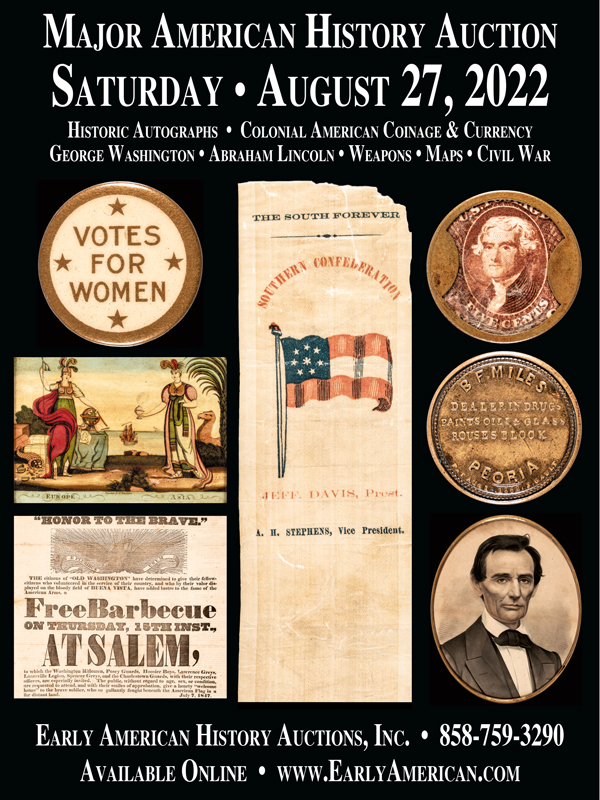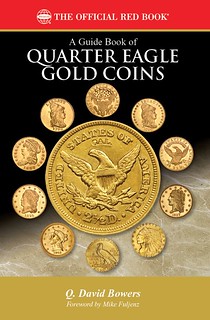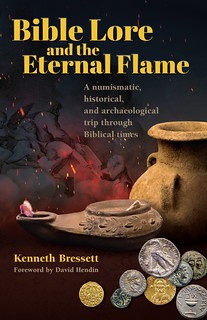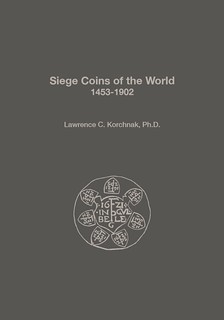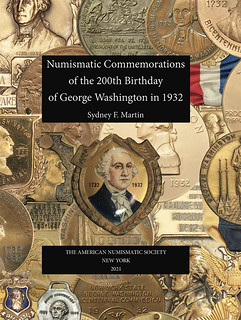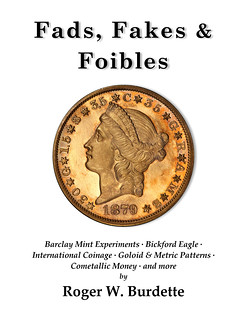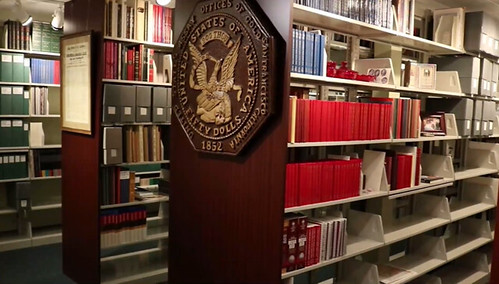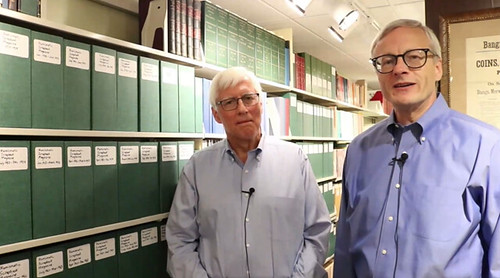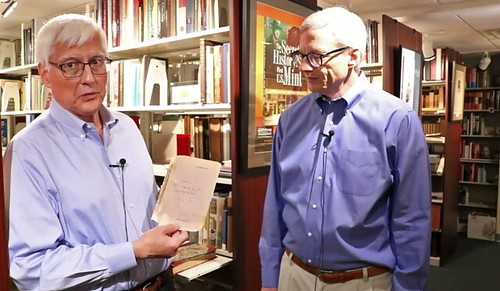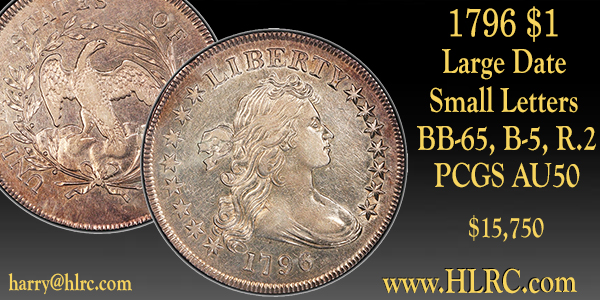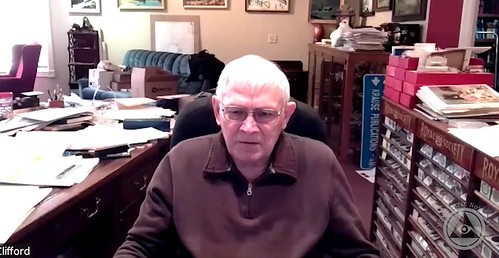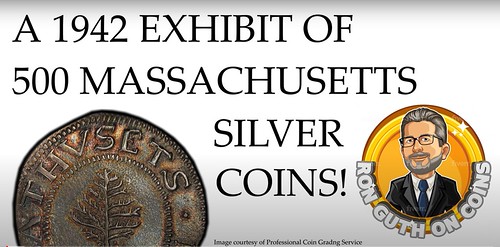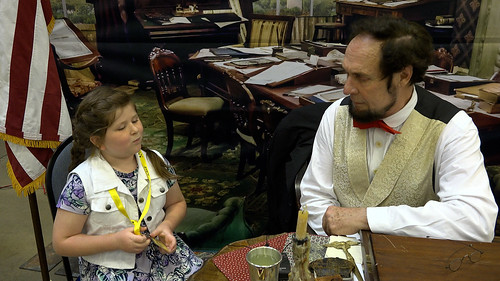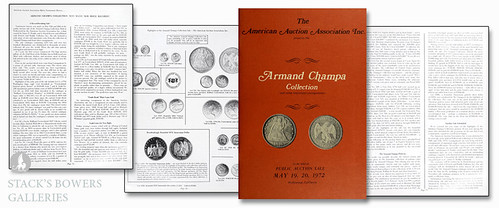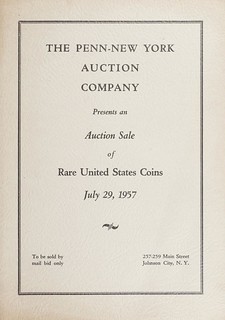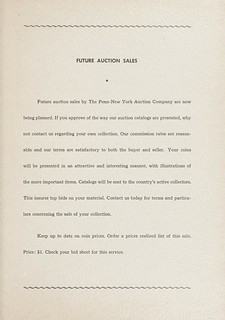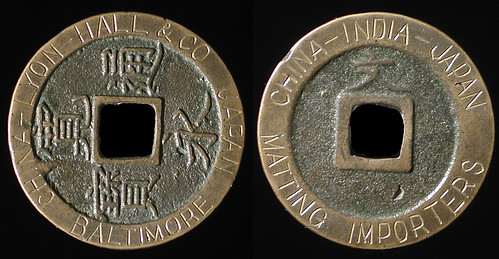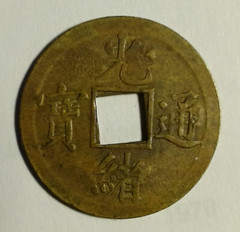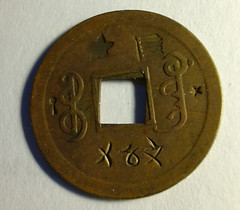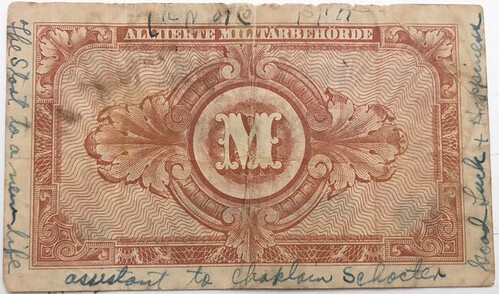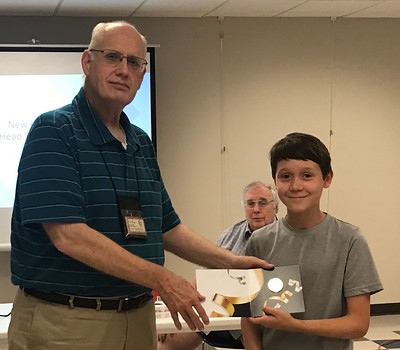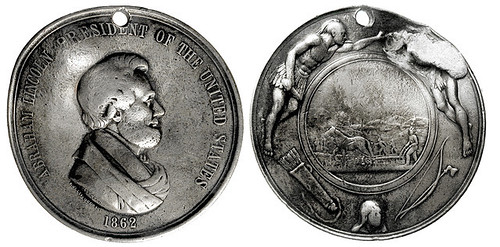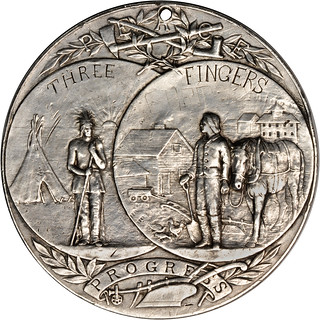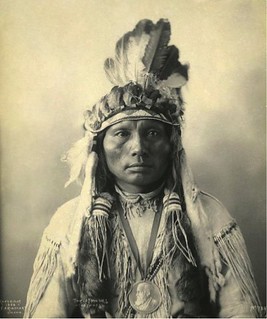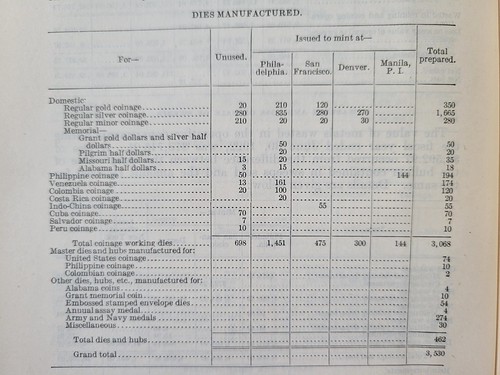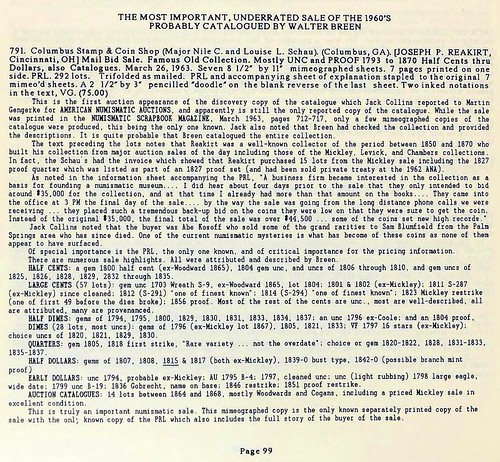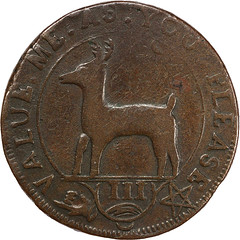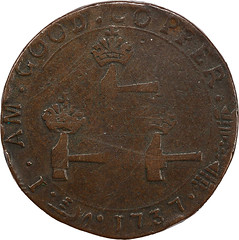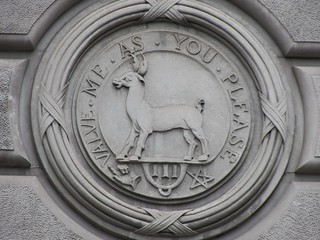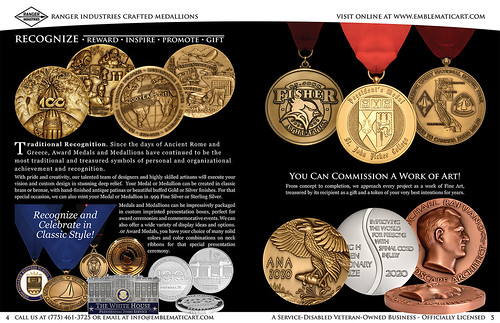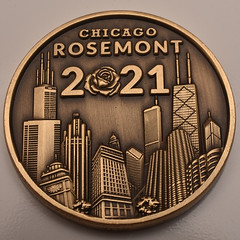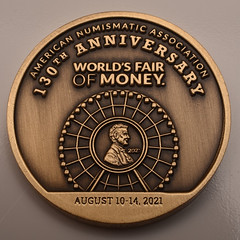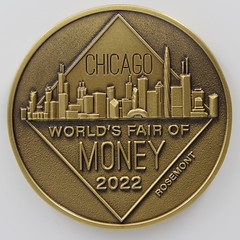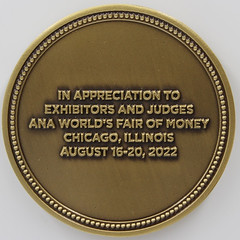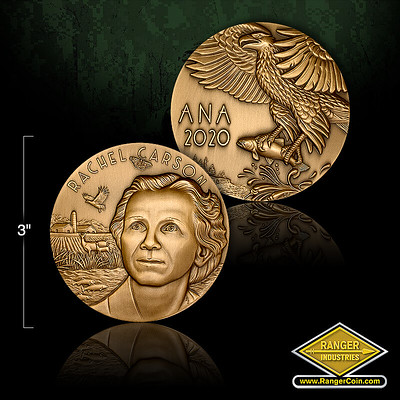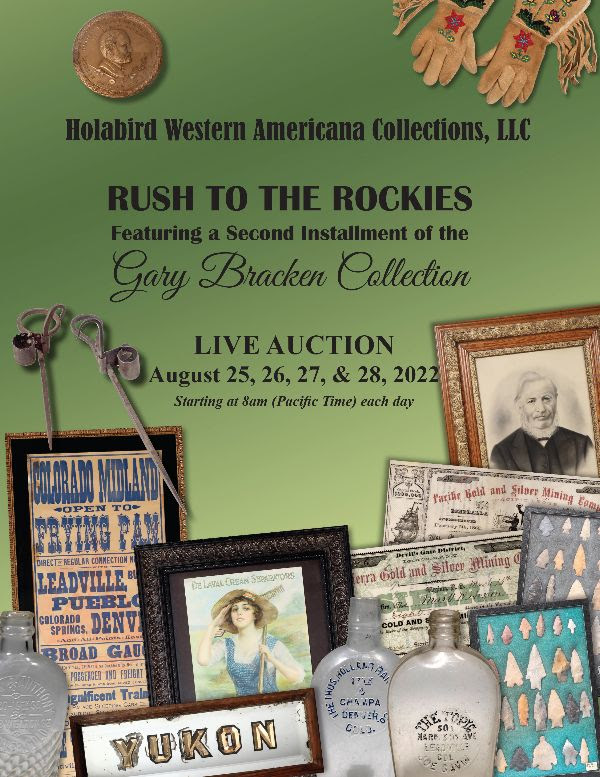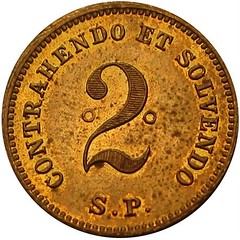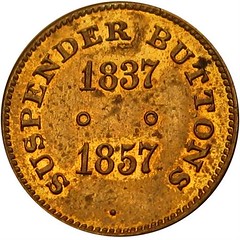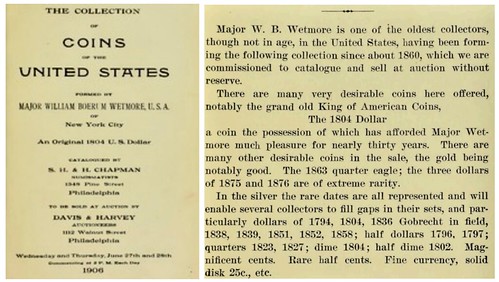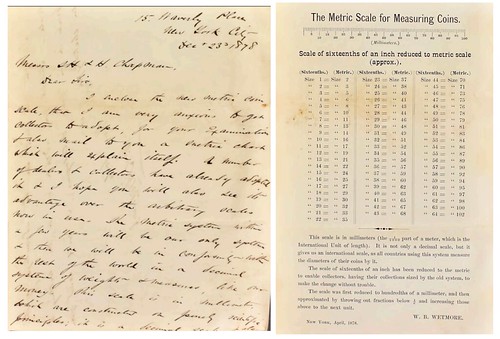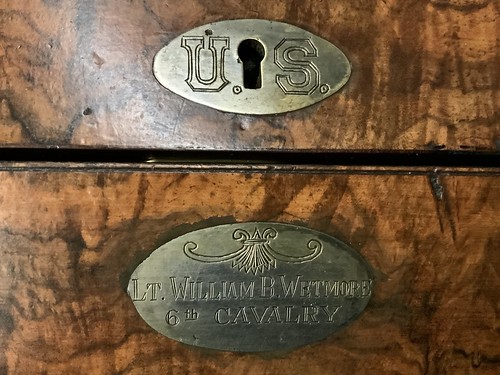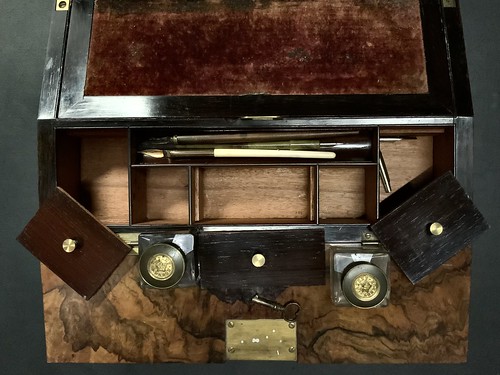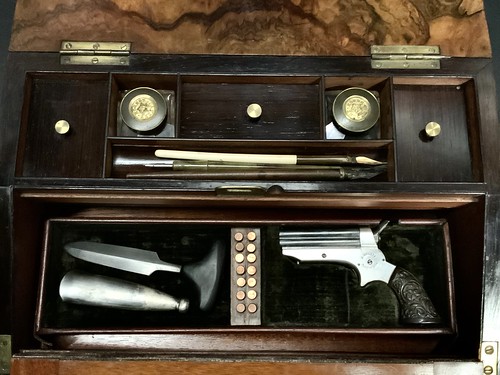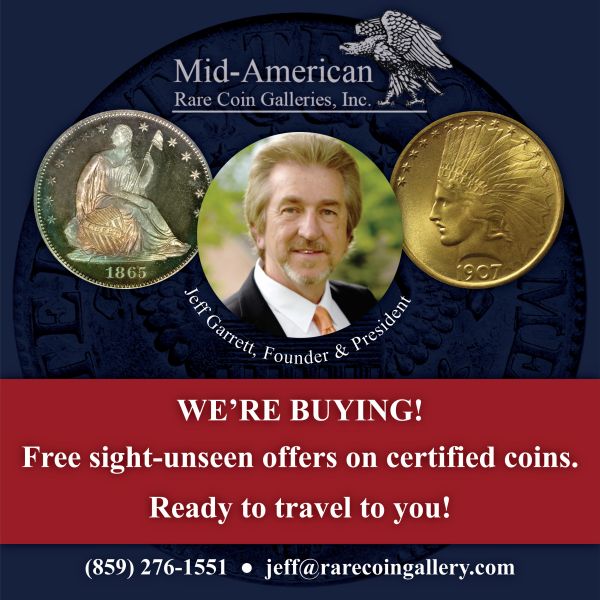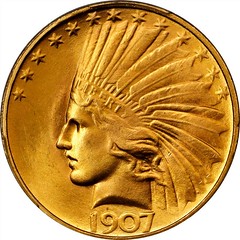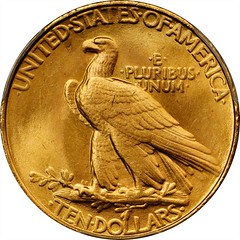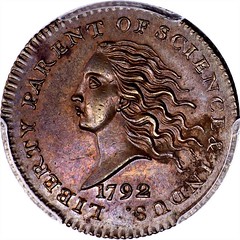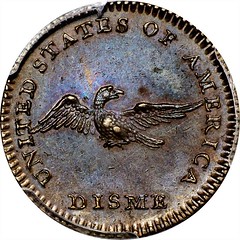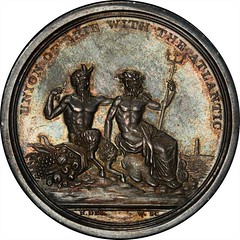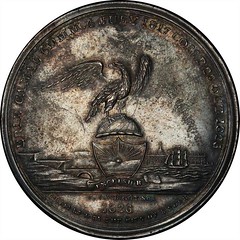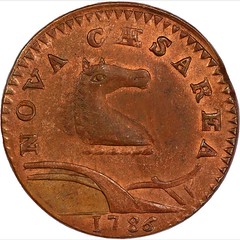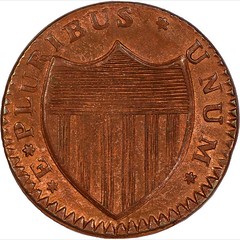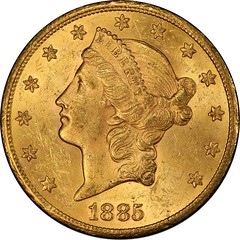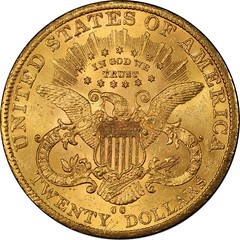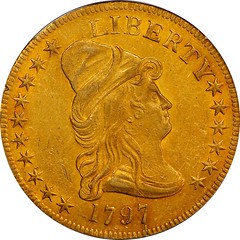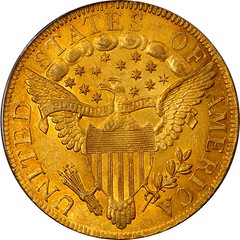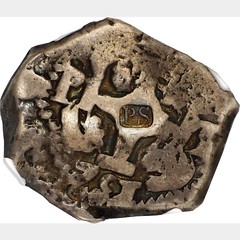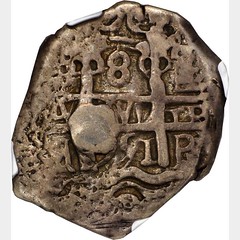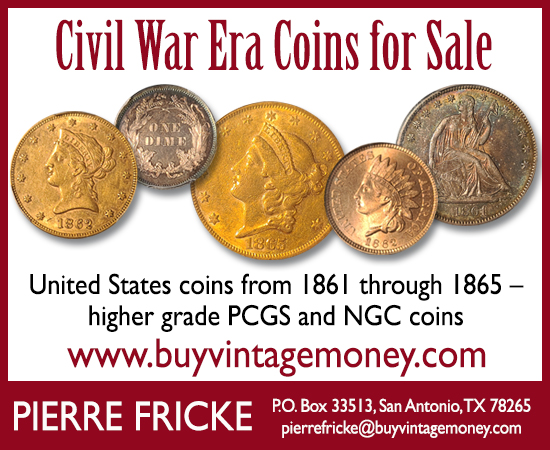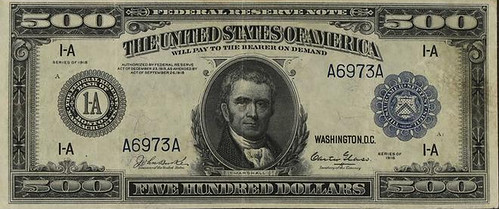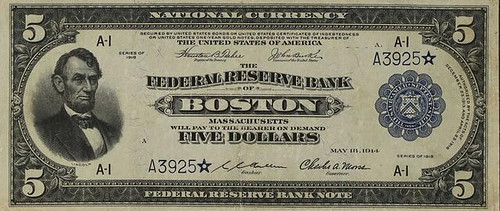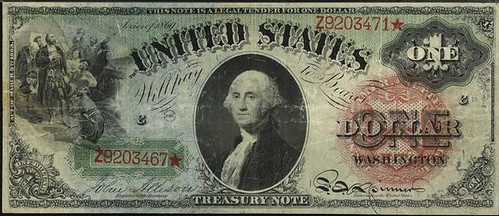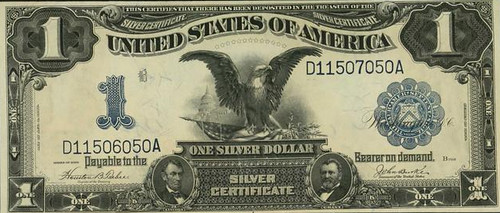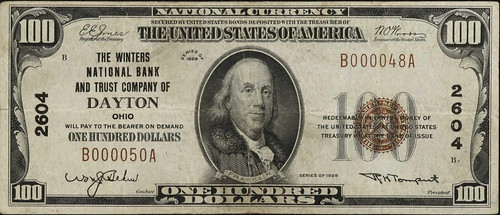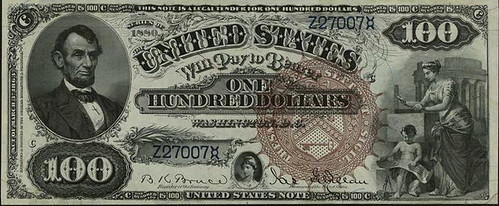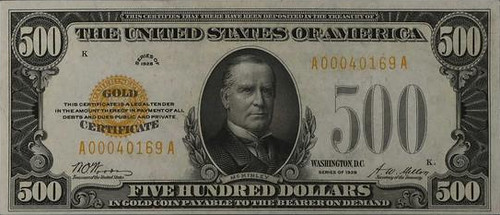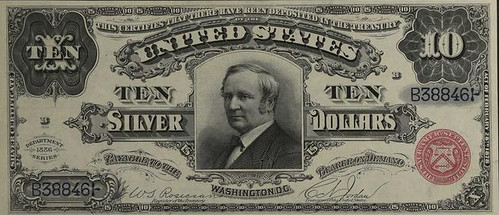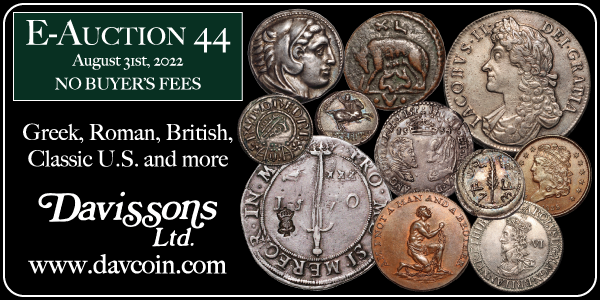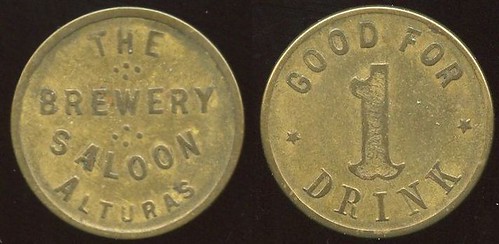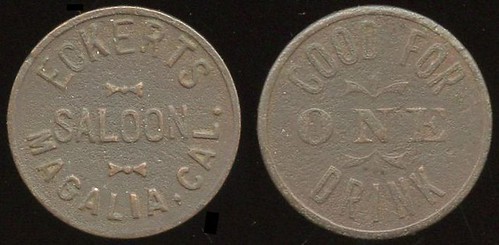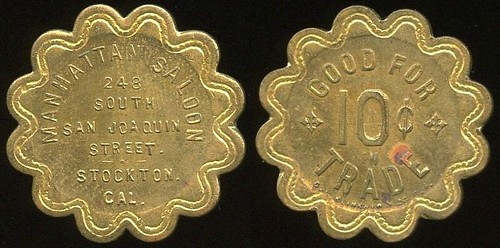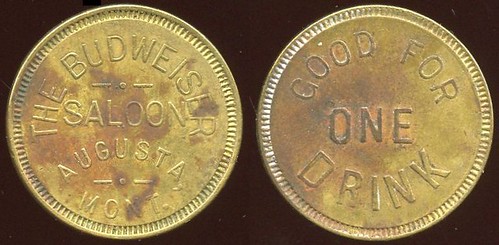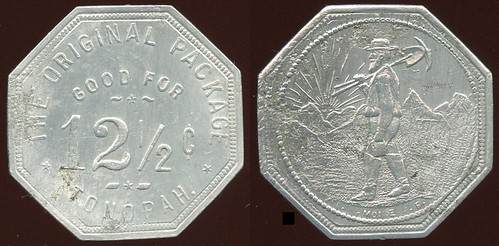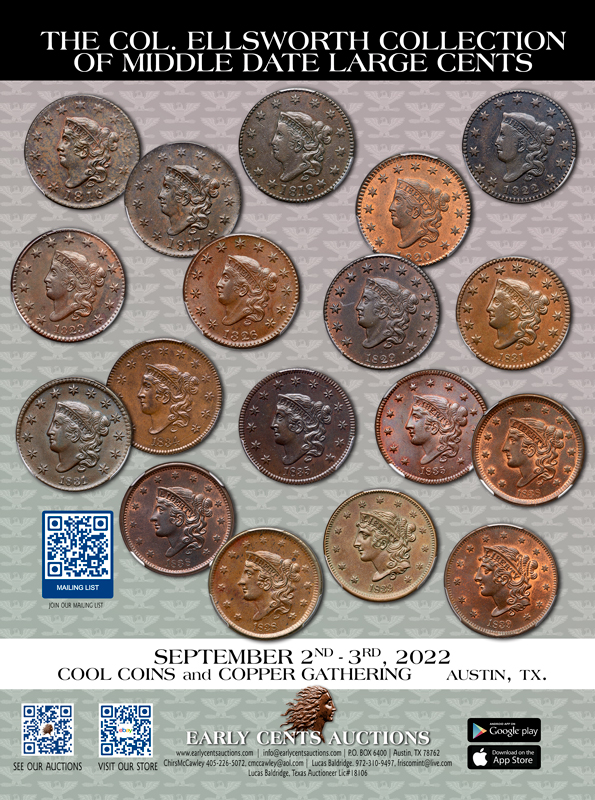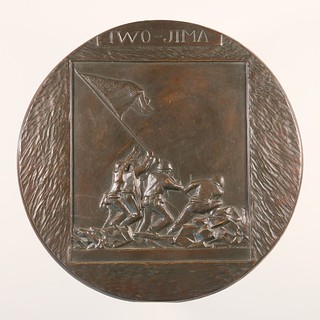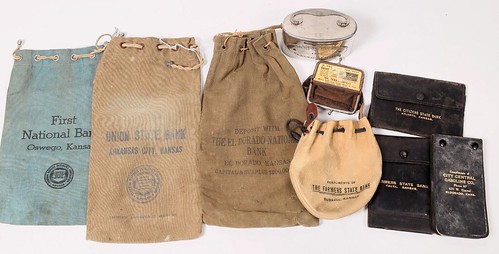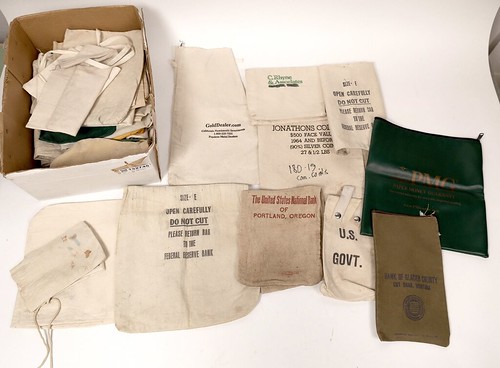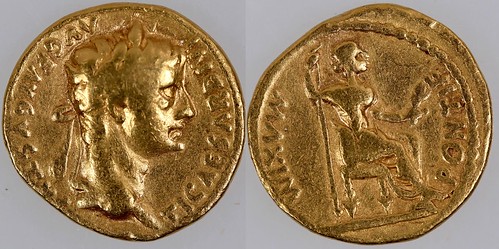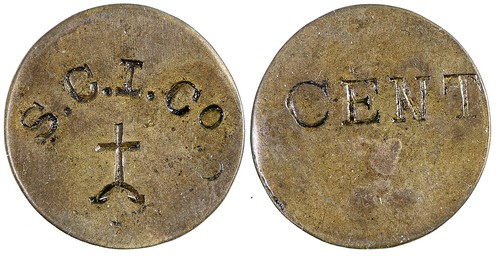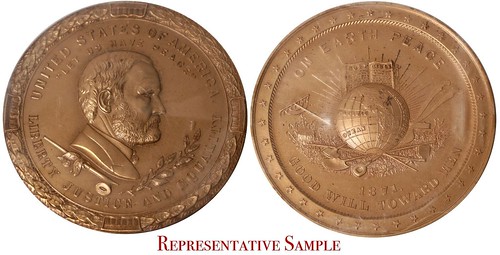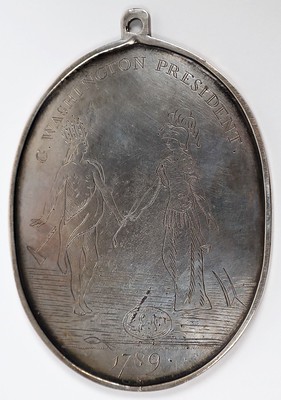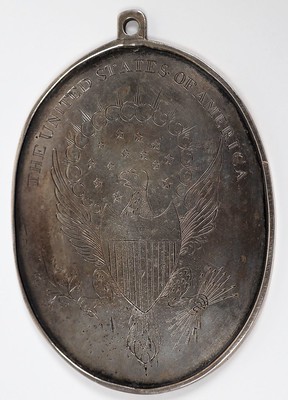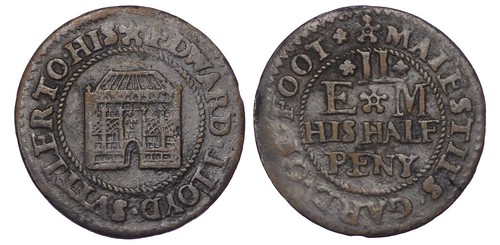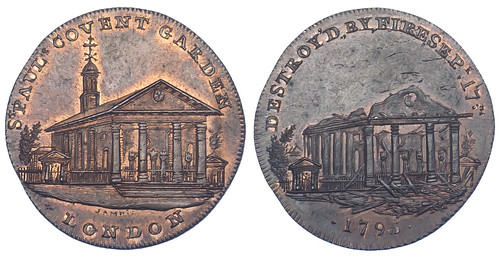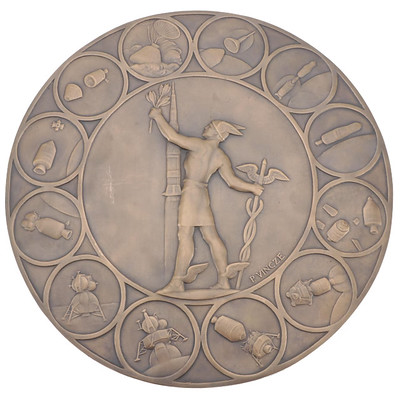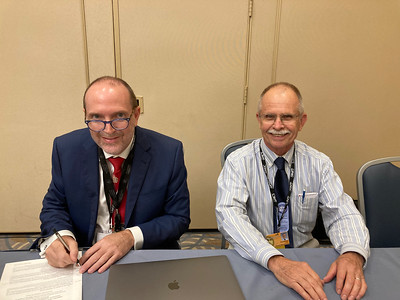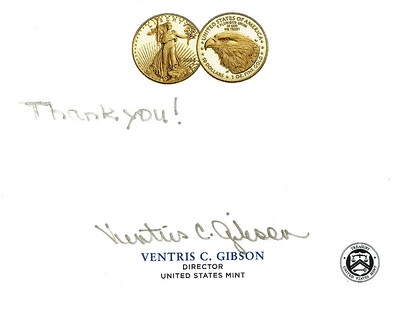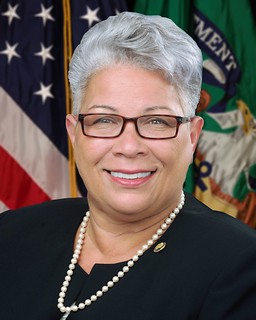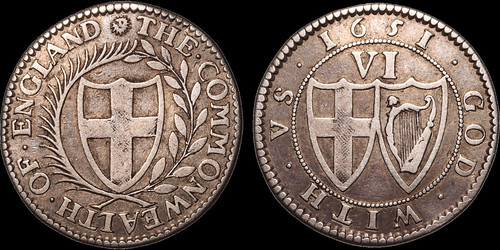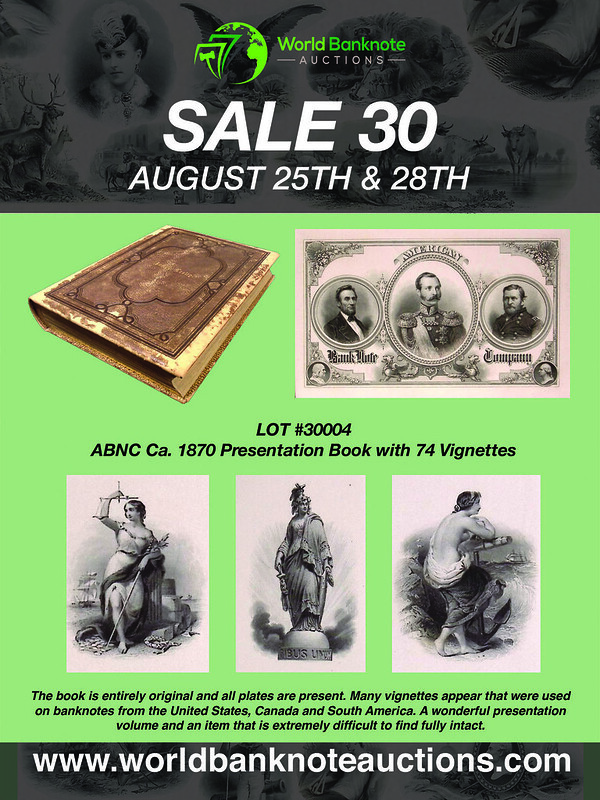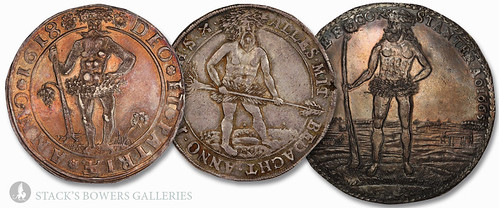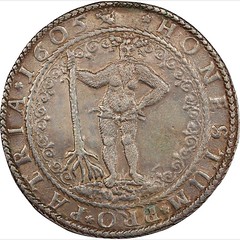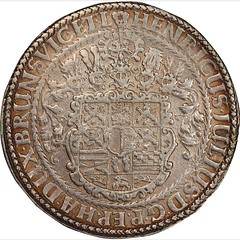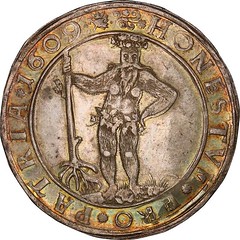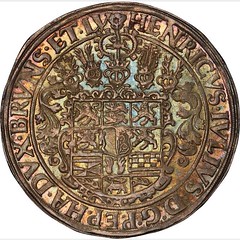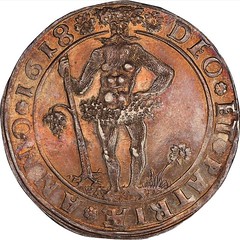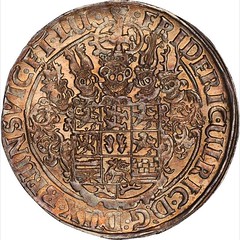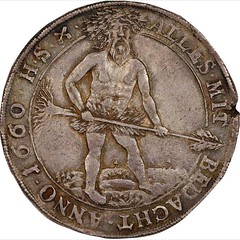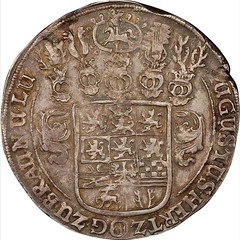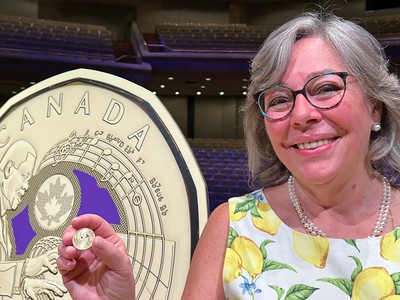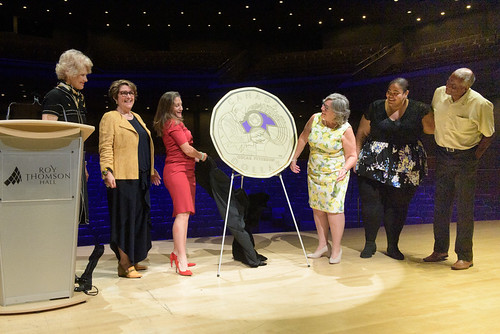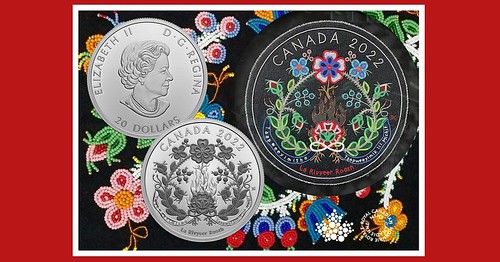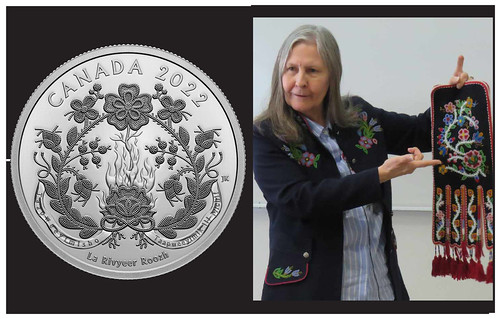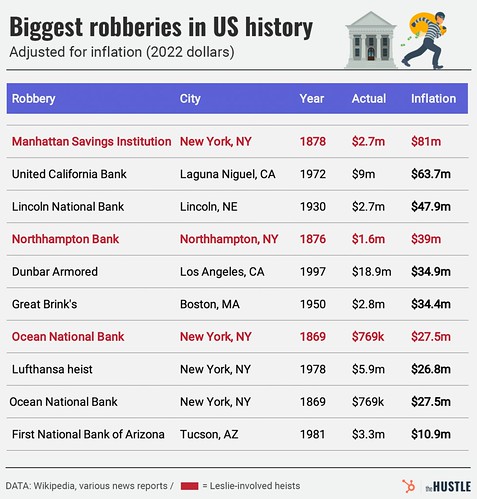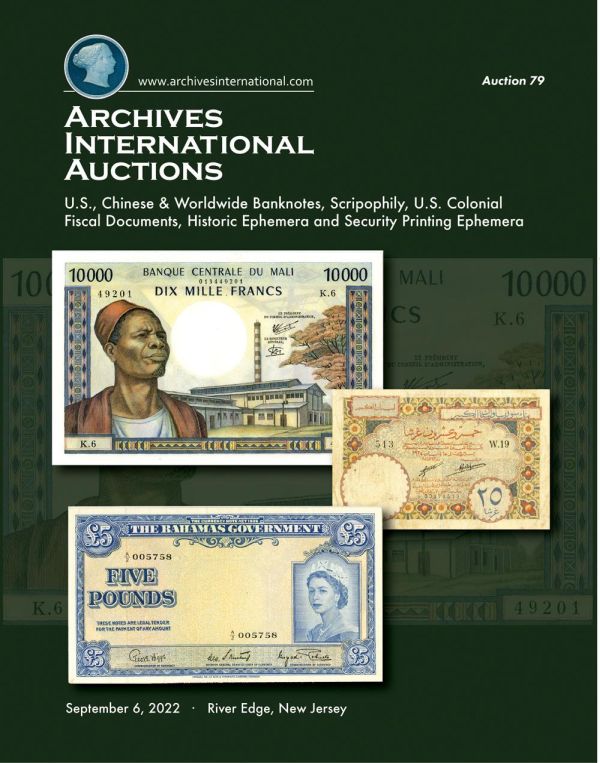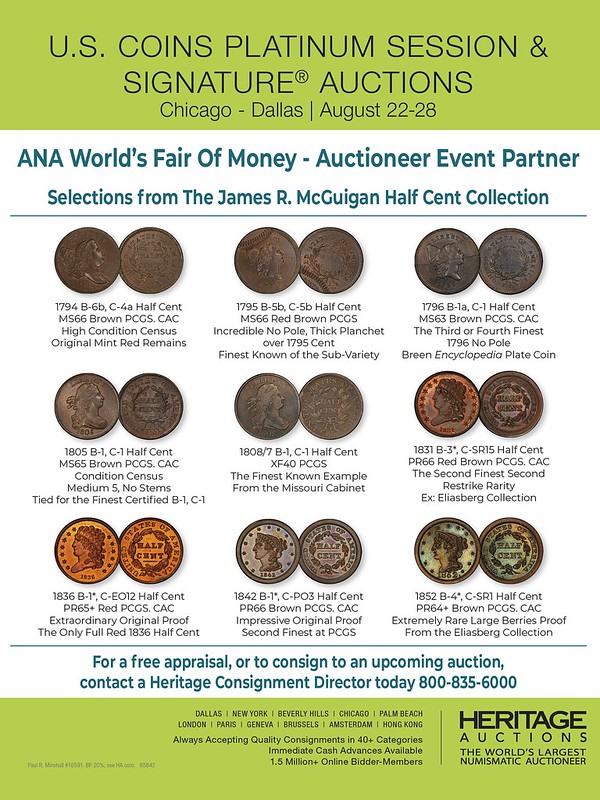
Visit our NBS Sponsors



About UsThe Numismatic Bibliomania Society is a non-profit association devoted to the study and enjoyment of numismatic literature. For more information please see our web site at coinbooks.org SubscriptionsThose wishing to become new E-Sylum subscribers (or wishing to Unsubscribe) can go to the following web page link MembershipThere is a membership application available on the web site Membership Application To join, print the application and return it with your check to the address printed on the application. Print/Digital membership is $40 to addresses in the U.S., and $60 elsewhere. A digital-only membership is available for $25. For those without web access, write to: Charles Heck, Treasurer AsylumFor Asylum mailing address changes and other membership questions, contact Chuck at this email address: treasurer@coinbooks.org SubmissionsTo submit items for publication in The E-Sylum, write to the Editor at this address: whomren@gmail.com BUY THE BOOK BEFORE THE COINSale Calendar |
- WAYNE'S WORDS: THE E-SYLUM AUGUST 21, 2022
- NBS 2022 ANA CONVENTION REPORT
- MORE KOLBE & FANNING 2022 SUMMER HIGHLIGHTS
- WBNA OFFERS RARE BANKNOTE VIGNETTE BOOK
- 2022 NUMISMATIC LITERARY GUILD AWARDS
- THE JOEL OROSZ NUMISMATIC LIBRARY TOUR
- NUMISMATIC NOTABLES: CLIFFORD MISHLER
- THE 1942 ANS EXHIBIT OF MASSACHUSETTS SILVER
- VIDEO: WHAT A GIRL ASKED PRESIDENT LINCOLN
- NOTES FROM E-SYLUM READERS: AUGUST 21, 2022
- THE TRILOBITE COINS OF VERMONT
- RANGER INDUSTRIES
- VOCABULARY TERM: LIMITING GUIDE
- WILLIAM WETMORE'S TRAVELING DESK
- ANS ANNOUNCES RESOLUTE AMERICANA CHAIR
- NAC AND SHANNA SCHMIDT FORM NAC USA
- STACK'S BOWERS SUMMER 2022 AUCTIONS
- STACK'S BOWERS SUMMER 2022 U.S. CURRENCY
- MORE FEISEL AUGUST 2022 TOKEN HIGHLIGHTS
- HOLABIRD AUGUST 2022 SALE SELECTIONS
- LARRY SWICK
PEACE MEDAL
COLLECTION - NUMISMATIC NUGGETS: AUGUST 21, 2022
- 2022 ANA CONVENTION DIARY
- BLONDEAU'S COMMONWEALTH PATTERNS
- THE WILDMEN
- CANADA'S NEW OSCAR PETERSON COIN
- CANADIAN COIN FEATURES METIS BEADWORK
- GEORGE LESLIE, KING OF BANK ROBBERS
- FAUX WHAT IT'S WORTH
- REAL AND FAKE COIN-PUSHER VIDEOS
- FEATURED WEBSITE: ANCIENT COIN CLUB OF LOS ANGELES
Click here to read the thin version on the web
Click here to subscribe
Click here to access the complete archive
To comment or submit articles, reply to whomren@gmail.com
Content presented in The E-Sylum is not necessarily researched or independently fact-checked, and views expressed do not necessarily represent those of the Numismatic Bibliomania Society.
WAYNE'S WORDS: THE E-SYLUM AUGUST 21, 2022
 New subscribers this week include:
Rich Perilloux of the Ancient Coin Club of Los Angeles (ACCLA),
Welcome aboard!
New subscribers this week include:
Rich Perilloux of the Ancient Coin Club of Los Angeles (ACCLA),
Welcome aboard!
Thank you for reading The E-Sylum. If you enjoy it, please send me the email addresses of friends you think may enjoy it as well and I'll send them a subscription. Contact me at whomren@gmail.com anytime regarding your subscription, or questions, comments or suggestions about our content.
This week we open with a report on NBS events at this week's ANA convention, numismatic literature sales, the NLG awards, updates from the Newman Numismatic Portal, and more.
Other topics this week include the Joel J. Orosz numismatic library, an eye-popping exhibit of Massachusetts silver, the trilobite coins of Vermont, limiting guides, collector William Wetmore, dealer Shanna Schmidt, auction previews, more from the ANA convention, Wildman thalers, new Canadian coins, coin-pushers and bank robbers.
To learn more about the George Fredrick Kolbe Lifetime Achievement Award, Attinelli's Numisgraphics, Maris's Varieties of the Copper Issues of the United States Mint in the Year 1794, American Banknote Company vignettes, NLG's 2022 Book of the Year, Clifford Mishler's numismatic career, the Penn-New York Auction Company, the Numismatic Poet Society, Ranger Industries, the 1792 Copper Disme, and what a nine-year old girl asked President Lincoln, read on. Have a great week, everyone!
Wayne Homren
Editor, The E-Sylum
NBS 2022 ANA CONVENTION REPORT
Numismatic Bibliomania Society President Tom Harrison provided this report on NBS events at this week's American Numismatic Association convention in Rosemont, IL. Maria Fanning provided images of NBS events. Sorry I couldn't be there this year. I'll look forward to meeting with my numismatic friends at the Whitman Baltimore Expos, and the Pennsylvania Association of Numismatists (PAN) shows and next year's ANA in Pittsburgh. -Editor
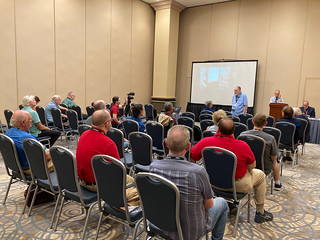 The ANA World's Fair of Money opened to the public Tuesday, August 16th at 1:00 PM. Again
this year, the NBS hosted a club table to promote the benefits and enjoyment of building a
numismatic library. The table was strategically located next to literature dealer Charles Davis's
booth. The table afforded convention goers the opportunity to purchase a NBS commemorative
coffee mug to support the NBS, view highlights of Friday's charity auction and connect with
fellow literature enthusiasts.
The ANA World's Fair of Money opened to the public Tuesday, August 16th at 1:00 PM. Again
this year, the NBS hosted a club table to promote the benefits and enjoyment of building a
numismatic library. The table was strategically located next to literature dealer Charles Davis's
booth. The table afforded convention goers the opportunity to purchase a NBS commemorative
coffee mug to support the NBS, view highlights of Friday's charity auction and connect with
fellow literature enthusiasts.
This year there was an outstanding nine-case literature display titled A Select Numismatic
Literature Collection.
Examples displayed in the award-winning display included rare items
authored by Dickeson, Ormsby and Beazel.
NBS Treasurer, Chuck Heck, presented an entertaining and informative talk detailing his research and the production of his outstanding new book, Die States of 1794 United States Large Cents at Thursday's Symposium. Chuck addressed a number of challenges and then detailed solutions to help prospective authors navigate the complexities of publication.
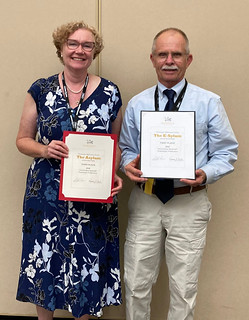 Photo: Maria Fanning and Tom Harrison holding ANA Awards
Photo: Maria Fanning and Tom Harrison holding ANA Awards
Highlights of Friday's General Meeting included the presentation of the George Fredrick Kolbe Lifetime Achievement Award, the annual charity auction, The Asylum author awards and a video tour of the amazing Joel Orosz numismatic library. The Kolbe Award was presented to long-time literature dealer, author and NBS supporter, Charles Davis, who served on the NBS Board and as editor of The Asylum. Again this year, several generous donors stepped up to provide fifty quality lots for the charity auction for which enthusiastic bidders competed to raise funds to support the NBS. On behalf of the NBS membership, I extend a heartfelt thank you to the open-handed members who raised over $10,000 for the NBS!
The Asylum's Jack Collins Award for the best
article by a first time author was presented to Charles Sullivan for his fine article The Curious
Evolution of a Classic Numismatic Reference.
Jim Neiswinter's outstanding article titled Two
Versions of the Levick Plate of 1793 Cents
received the Joel J. Orosz Award for the best article
appearing in The Asylum. In July, Len Augsburger and Lianna Spurrier produced a video
recording of NBS Historian, Joel Orosz's, extensive numismatic library. As a result of their
efforts and Joel's hospitality, we had an opportunity to enjoy a video tour and view a number of
special volumes including an extensive collection of NBS archival material dating back to the
society's inception. Following the formal part of the meeting, members were invited to remain
for an informal social time to share a special item from their libraries and connect with old
friends and make new acquaintances.
The bibliophiles' week was capped off with a well attended Money Talks presentation by NBS
Vice President, Len Augsburger, titled Building a Numismatic Library for Pleasure and Profit.
Len's discussion focused on different collecting strategies and the wide range of opportunities
collectors have to assemble a significant library regardless of one's budget.
It was a great week of biblio fun due to the efforts of many dedicated NBS members who generously gave of their time and resources. Many thanks to everyone for your continued commitment to the NBS!
For more on the Orosz Library video and additional photos from the convention, see articles elsewhere in this issue. -Editor
To view ANA photo albums on our Flickr archive, see:
https://www.flickr.com/photos/coinbooks/albums/72177720301476699
(https://www.flickr.com/photos/coinbooks/albums/72177720301476699)
https://www.flickr.com/photos/coinbooks/albums/72177720301482653
(https://www.flickr.com/photos/coinbooks/albums/72177720301482653)
For more information on NBS, see:
https://www.coinbooks.org/
MORE KOLBE & FANNING 2022 SUMMER HIGHLIGHTS
Here are some additional highlights from the Kolbe & Fanning 2022 Summer Americana sale of numismatic literature. Wow - this is an impressive sale, with opportunities to acquire rarities seen only once in a generation. -Editor
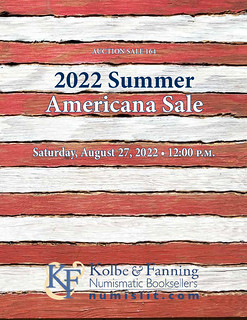 Kolbe & Fanning Numismatic Booksellers are holding our Summer Americana sale on Saturday, August 27, 2022. Featuring highlights from the Cardinal Collection Library of American numismatic auction catalogues, the Bourne Library of U.S. numismatic periodicals, and the Jim Neiswinter Library of works on U.S. large cents, the sale promises to be one of the most important of the year.
Kolbe & Fanning Numismatic Booksellers are holding our Summer Americana sale on Saturday, August 27, 2022. Featuring highlights from the Cardinal Collection Library of American numismatic auction catalogues, the Bourne Library of U.S. numismatic periodicals, and the Jim Neiswinter Library of works on U.S. large cents, the sale promises to be one of the most important of the year.
Some highlights of the sale include:
Lot 3: the only known copy of Geoffrey Charlton Adams's 1906 Dixie Land sale with both photographic plates
Lot 19: Attinelli's 1876 Numisgraphics, the foundational bibliography of U.S. numismatic literature
Lot 50: an original 1925 edition of Ard W. Browning's Early Quarter Dollars of the United States, with 8 fine photographic plates
Lot 86: a plated copy of S.H. & H. Chapman's 1904 catalogue of the Ralph Barker collection, from the library of Homer K. Downing
Lot 133: S.H. Chapman's personal plated copy of his catalogue of the Dr. J.M. Henderson sale, in splendid condition
Lots 186: Tom Elder's 1917 catalogue of the George Carlton collection, with 5 fine plates, from the Lyman H. Low library
Lots 299 and 300: both the 1869 and 1870 editions of Edward Maris's Varieties of the Copper Issues of the United States Mint in the Year 1794
Lot 223: Ed Frossard's very rare and controversial offering of works by John Trumbull, one of the key rarities of his series
Lot 438: Carl Würtzbach's copy of the deluxe plated edition of the United States Coin Company's 1915 catalogue of the H.O. Granberg collection.
Lot 402: the Eshbach-Cardinal collection of Charles Steigerwalt catalogues, the most complete set ever offered at auction
Register early to bid online
Bids may be placed via post, email, fax or phone, as well as online. Kolbe & Fanning use Auction Mobility as our third-party online bidding platform. Auction Mobility is an app-based platform allowing users the ability to participate in the sale through phones, tablets and computers. To register for the sale, bidders must go to bid.numislit.com and sign up. Once you have set up an account, you may browse lots, place advance bids, or participate in the live sale online. Those wishing to participate on their devices can download the Kolbe & Fanning app through the Apple or Google Play Store. The sale is also listed on Biddr and NumisBids.
The printed catalogue of the Summer Americana sale has been mailed to active customers on our mailing list. As international mail speeds have been inconsistent, we encourage our foreign clients to consult the electronic catalogue in case their printed catalogue does not arrive promptly. A PDF of the printed catalogue has been posted to our main website at numislit.com for those who prefer that format. Bids placed via post, email, fax or phone must be received by August 26, the day before the sale, in order for them to be processed. Advance absentee bids may also be placed at any time online at bid.numislit.com. Live internet bidding will be available during the sale itself through the same platform.
Kolbe & Fanning Numismatic Booksellers LLC is a licensed and bonded auction firm in the State of Ohio. For more information, please see the Kolbe & Fanning website at numislit.com or email David Fanning at df@numislit.com. To register for the sale, go to bid.numislit.com. We look forward to your participation.
To read the earlier E-Sylum articles, see:
KOLBE & FANNING 2022 SUMMER AMERICANA SALE
(https://www.coinbooks.org/v25/esylum_v25n32a03.html)
KOLBE & FANNING 2022 SUMMER SALE HIGHLIGHTS
(https://www.coinbooks.org/v25/esylum_v25n33a03.html)
WBNA OFFERS RARE BANKNOTE VIGNETTE BOOK
In a rare opportunity for bibliophiles and currency collectors, World Banknote Auctions is offering a presentation book of vignettes produced by the American Banknote Company. -Editor
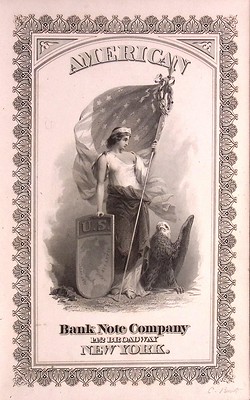 World Banknote Auctions has now launched Live Sale 30 at www.worldbanknoteauctions.com. Live Sale 30 starts on August 25, 2022, with live bidding that day at 1 PM Eastern / 10 AM Pacific. Please note that Sale 30 is divided in two parts, each selling on a different day. The first live sale with 547 lots takes place on August 25 at 10 AM PST. The second timed sale with 471 lots starts to close on August 28 at 3 PM PST (special bidding rules apply for the timed sale, please see our website for details). Our bidding platform can be accessed directly by going to
bid.worldbanknoteauctions.com or through our mobile apps.
World Banknote Auctions has now launched Live Sale 30 at www.worldbanknoteauctions.com. Live Sale 30 starts on August 25, 2022, with live bidding that day at 1 PM Eastern / 10 AM Pacific. Please note that Sale 30 is divided in two parts, each selling on a different day. The first live sale with 547 lots takes place on August 25 at 10 AM PST. The second timed sale with 471 lots starts to close on August 28 at 3 PM PST (special bidding rules apply for the timed sale, please see our website for details). Our bidding platform can be accessed directly by going to
bid.worldbanknoteauctions.com or through our mobile apps.
One of the most interesting and unique items in the sale is a presentation book of vignettes produced by the American Banknote Company, most likely sometime in the late 1860s or 1870s. The book, offered as lot 30004 in the sale, contains 74 individual vignettes, many which appear on banknotes from the United States, Canada and South America. The book has the name Joseph Lesley on the front cover, and appears to have been presented to him. Intact books such as this are extremely rare, and we are aware of just a few intact books that have sold publicly in the past three decades. The book was carefully produced, with gilded edges, and while it does display some wear (as would be expected from a book of this age) it is completely intact and no individual plates appear to be missing.
A fascinating page appears early in the book, and is a full page engraving containing the portrait of Czar Alexander II of Russia, flanked by U.S. Presidents Lincoln and Grant. This engraving, which is quite rare by itself, appears to have been produced after Alexander II freed the Serfs in Russia in 1861 and after, according to some historians, the Czar aided the Union during the American Civil War by sending Russian ships into American waters in the same year. While some historians dispute the role Alexander II played in the conflict, the fact that he appears on this engraving fairly shortly after both those events indicates that he did gain some notoriety in the United States at the time.
The book contains vignettes with a wide range of topics, including allegories, natural scenes and historical figures. There is no particular order to the vignettes, and with each page being turned there is a new scene or figure to be discovered. All engravings are typical of the high quality product that the American Banknote Company was able to produce at the time that this book was made.
World Banknote Auctions has created a page on its website where all pages of the book have been photographed, giving bidders a rare look at the entire book and all the vignettes. Additionally many banknotes on which these vignettes appear have been identified, highlighting the diversity of the book, as many different issuers and locales can be found. In all, this book represents a fascinating and rare opportunity to acquire a completely intact copy of an ABNC presentation book from the 19th century.
The online gallery of vignette images is a marvelous resource for collectors and researchers! Many of the vignette images are annotated with lists of the banknotes on which they appear. Here are a few more examples. -Editor
To review the gallery of vignettes, see:
American Banknote Company Presentation Book
(https://www.worldbanknoteauctions.com/abnc_presentation_book/)
To read the complete article, see:
World Banknote Auctions Offers Rare ABNC Presentation book
(https://www.worldbanknoteauctions.com/news/world-banknote-auctions-offers-abnc/)
2022 NUMISMATIC LITERARY GUILD AWARDS
The Numismatic Literary Guild (NLG) is a separate organization from ours, the Numismatic Bibliomania Society (NBS). But we share a love of the numismatic hobby and numismatic research and writing in particular. Congratulations to all of the winners, many of whom are E-Sylum and NBS regulars. Here are this year's Awards Competition results. I've added images of some of the books which were announced or reviewed in earlier E-Sylum issues. See the links below for more information about adding these award-winners to your numismatic library.
Founded in 1968, the NLG is a nonprofit organization open to any editors, reporters, authors, writers, catalogers, webmasters, bloggers or producers of audio or video involving all forms of money, medals, tokens and other numismatic collectibles. Information about applying for NLG membership is available online at www.NLGonline.org/membership. -Editor
1. BEST SPECIALIZED BOOKS
a. United States or Related Coins
A Guide Book of Quarter Eagle Gold Coins –
Q. David Bowers
b. Ancient and Medieval Coins
Bible Lore and the Eternal Flame: A Numismatic, Historical & Archaeological Trip Through Biblical Times –
Kenneth Bressett
c. World Coins
Siege Coins of the World 1453-1902 –
Lawrence C. Korchnak, PhD
d. Paper Money
(no entries)
e. Tokens & Medals
Numismatic Commemorations of the 200th Birthday of George Washington in 1932 –
Sydney F. Martin
f. Numismatic Investment or Marketplace
Type II Double Eagles – 1866 to 1876 –
Dr. Mike Fuljenz
g. Numismatic History or Personalities
Fads, Fakes & Foibles –
Roger W. Burdette
2. BOOK OF THE YEAR
Randall P. Clark
3. NUMISMATIC FEATURE ARTICLES
a. United States Coins – Early
The Coins Made ‘for the Islands and Mainland of America' by the French West India Company 1670
– Jérôme Jambu – Journal of Early American Numismatics
b. United States Coins – Modern
Saint-Gaudens' Model: from Victory to the Glimmering Gold $20, Hettie Anderson Inspired Many
– Robert R. Van Ryzin – Numismatic News
c. Ancient and Medieval Coins
Coins and the Colosseum: How Coinage Illuminates the Greatest Amphitheater
– Nathan T. Elkins – ANS Magazine
d. World Coins
The Origins and Context of the First Coinage for Liberia
– Bill Dalzell – American Journal of Numismatics
e. Paper Money
North Carolina's First Currency Printer
– David E. Schenkman – The Numismatist
f. Tokens & Medals
Company Stores and Scrip in America
– David E. Schenkman – The Numismatist
g. Numismatic Investment or Marketplace
Big Lessons in Small Coins: Numismatics Changed after the Pandemic
– Joshua McMorrow-Hernandez - COINage
h. Numismatic History or Personalities
The Crane Ring of Rupert, Vermont: A Family of Counterfeiters at Reuben Harmon's Mint
– Julia Casey – Journal of Early American Numismatics
4. NUMISMATIC COLUMNS
a. United States Coins – Early
Introduction by the Editor
– Harry Salyards – Penny-Wise
b. United States Coins – Modern
USA Coin Album
– David W. Lange – The Numismatist
c. Ancient or Medieval Coins
NGC Ancients
– NGC eNews
d. World Coins
Counterfeit Detection
– NGC eNews
e. Paper Money
Uncoupled: Paper Money's Odd Couple
– Fred Schwan & Joseph E. Boling – Paper Money
f. Tokens & Medals
Tokens & Medals
– David E. Schenkman – The Numismatist
g. Numismatic Investment or Marketplace
Weekly Market Report
– Jim Bisognani – NGC eNews
h. Numismatic History or Personalities
Past Times with Coins: The Story of ‘Ye Old Mint'
– Robert R. Van Ryzin – Numismatic News
5. PERIODICALS
a. Best Investment Newsletter
The Rosen Numismatic Advisory – Maurice Rosen, Editor
b. Best Professional Periodical
Coin World – William T. Gibbs, Managing Editor
c. Best Club or Not-for-Profit Periodical
– Large Circulation
The Numismatist – Caleb Noel, Editor-in-Chief
d. Best Club or Not-for-Profit Periodical
– Small Circulation
Paper Money – Benny Bolin, Editor
6. WEBSITES
a. Best Online News Website
(no entries)
b. Best Dealer or Industry Website
Coins.HA.com – Heritage Auctions
c. Best Non-Trade Website
Numismatics.org – American Numismatic Society
d. Best Numismatic Social Media Platform or
Coin Collector Forum
facebook.com/AmericanNumismaticSociety - ANS
e. Best Blog
numismatics.org/pocketchange – American Numismatic Society
7. AUCTION OR FIXED-PRICE CATALOGS
a. Best U.S. Coin Auction Catalog
The August 2021 ANA Rarities Night – Stacks Bowers Galleries
b. Best World Coin Auction Catalog
Triton XXV – Classical Numismatic Group
c. Best Paper Money Auction Catalog
The Mike Coltrane Collection, Part 2 – Heritage Auctions
d. Best Book or Exonumia Auction Catalog
The E Pluribus Unum Collection, Part 3 – Stack's Bowers Galleries
8. AUDIO-VISUAL
a. Audio Coin World Podcast –
Jeff Starck & Larry Jewett
b. Video
A Behind-the-Scenes Look at the Hansen Collection –
Lianna Spurrier – Newman Numismatic Portal
c. Still Photography
1907 $20 HR Saint Gaudens Flat Rim MS67 –
Jack McNamara – Rare Collectibles TV
d. Software or App
www.HA.com/live -
Heritage Auctions
9. SPECIAL AWARDS
a. Lee Martin Founder's Award - Best All-Around Portfolio
Greg Reynolds
d. The Ribbit
John Kraljevich
e. The Clemy
John Dannreuther
Book of the Year author Randy Clark writes:
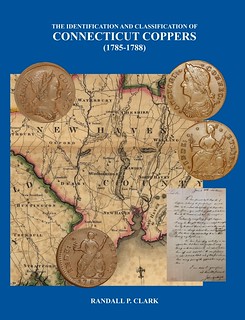 "The Colonial Coin Collectors Club (C4) and I are delighted to have been awarded
the prestigious NLG Book of the Year award for 2022. A heartfelt thank you goes out to the NLG organization and to John Kraljevich for accepting the award on C4's behalf!
"The Colonial Coin Collectors Club (C4) and I are delighted to have been awarded
the prestigious NLG Book of the Year award for 2022. A heartfelt thank you goes out to the NLG organization and to John Kraljevich for accepting the award on C4's behalf!
"The Identification and Classification of Connecticut Coppers is another great accomplishment for the C4 organization and the award is an important acknowledgement for the author and editors who worked as a team to help complete the work. A special thank you also goes out for supporting contributions from the C4 Board, Publications Committee, Membership and my family who all helped make publishing this book possible."
Congratulations to all the winners! -Editor
To read the earlier E-Sylum article, see:
IN APPRECIATION OF QUARTER EAGLE GOLD COINS
(https://www.coinbooks.org/v25/esylum_v25n06a02.html)
NEW BOOK: BIBLE LORE AND THE ETERNAL FLAME
(https://www.coinbooks.org/v25/esylum_v25n05a03.html)
NEW BOOK: SIEGE COINS OF THE WORLD 1453-1902
(https://www.coinbooks.org/v24/esylum_v24n27a04.html)
NEW BOOK: COMMEMORATIONS OF WASHINGTON
(https://www.coinbooks.org/v24/esylum_v24n48a06.html)
NEW BOOK: FADS, FAKES & FOIBLES
(https://www.coinbooks.org/v24/esylum_v24n24a02.html)
NEW BOOK: CONNECTICUT COPPERS (1785-1788)
(https://www.coinbooks.org/v24/esylum_v24n29a03.html)
THE JOEL OROSZ NUMISMATIC LIBRARY TOUR
The latest addition to the Newman Numismatic Portal is a video tour of the Joel Orosz Numismatic Library. Project Coordinator Len Augsburger provided the following report. -Editor
The Joel Orosz Numismatic Library Tour
On July 14, 2022, Len Augsburger and Lianna Spurrier visited the Joel Orosz library with the idea of presenting a video tour of the library highlights. Produced by Lianna Spurrier, this video premiered at the Numismatic Bibliomania Society (NBS) meeting at the ANA convention on August 19. Joel walks us through the library highlights, including antebellum literature related to numismatics, numismatic association items, the NBS archives, and more. Thanks to Joel Orosz for hosting this event and allowing us to share his library with a wider audience.
I dropped everything to sit and watch this. It's wonderfully done, and should be mandatory for every card-carrying NBS member and anyone interested in American numismatic literature and numismatic history. -Editor
Link to Joel Orosz Library Tour on Newman Portal:
https://archive.org/details/OroszLibraryTour
NUMISMATIC NOTABLES: CLIFFORD MISHLER
But wait, there's more! Another recent addition to the Newman Numismatic Portal is a two-part video interview with Clifford Mishler. Project Coordinator Len Augsburger provided the following report. -Editor
Numismatic Notables: Clifford Mishler
Newman Portal is pleased to present an in-depth, two-part interview with Clifford Mishler, who, along with Chet Krause, led Krause Publications for many years. In the first episode, Cliff discusses how he got involved in numismatics and his early days at Krause Publications, leading up to the first edition of Krause's Standard Catalog of World Coins. In part two, Mishler discusses the IT behind the Standard Catalog of World Coins, succession planning at Krause Publications, and the American Numismatic Association governance. Interviewed by Joel Orosz and Len Augsburger, this video was produced by Lianna Spurrier of Numismatic Marketing.
What a great oral history of the hobby! -Editor
Link to Clifford Mishler interviews on Newman Portal
https://nnp.wustl.edu/library/multimediadetail/529486?Year=2022&take=50
THE 1942 ANS EXHIBIT OF MASSACHUSETTS SILVER
The Newman Numismatic Portal stars in a great new video on the landmark 1942 ANS exhibit of Massachusetts silver coinage published by Ron Guth. Check it out - what a mind-blowing exhibit, and great numismatic history. -Editor
In 1942, the American Numismatic Society hosted an exhibit of approximately 500 Massachusetts Silver Coins dated circa 1652. The exhibition included loans from prominent collectors such as T. James Clarke, Carl Wurtzbach, and William B. Osgood Field (who owned a record number of eight New England Shillings and one New England Sixpence). The American Numismatic Society memorialized the exhibit in a photo album that currently resides in their collection and which has been made available on the Newman Numismatic Portal. For anyone interested in early American Colonial coins and, specifically, Massachusetts Silver coins, this video is a first look at this little-known photo album and exhibit.
To watch the complete video, see:
Ron Guth on Coins 15 - A 1942 Exhibit of 500 Massachusetts Silver Coins
(https://www.youtube.com/watch?v=LqFHuSR0LZA)
VIDEO: WHAT A GIRL ASKED PRESIDENT LINCOLN
These are selections from the David Lisot Video Library that feature news and personalities from the world of coin collecting. David has been attending coin conventions since 1972 and began videotaping in 1985. The Newman Numismatic Portal now lists all David's videos on their website at:
https://nnp.wustl.edu/library/multimediadetail/522852
Here's one with a young lady numismatist's questions for President Abe Lincoln. -Editor
What Would a Nine-Year Old Girl Ask President Lincoln?
VIDEO: 7:11.
Allisa Dyer, Young Numismatist,
Dennis Boggs, Abraham Lincoln,
David Lisot, Video Producer, CoinTelevision.com.
May 20, 2022.
There was a young lady who came to the Pennsylvania Association of Numismatists Coin Show and worked as a page. While there she decided to interview President Abraham Lincoln. What she asked him was extraordinary.
David adds:
"The PAN Coin Convention is dedicated to promoting coin collecting to the youth of America. As a way to do this, these kids interested in coins can be pages at the coin conventions and help dealers by getting them food or cleaning their showcases. One girl who was a page wanted to interview Abraham Lincoln. We caught her on camera doing so. Find out why this young lady numismatist could end up being our next US president!"
An excerpt of the video is available for viewing on the Coin Television YouTube Channel at:
https://youtu.be/kSEATo6FAe8
NOTES FROM E-SYLUM READERS: AUGUST 21, 2022
The Penn-New York Auction Company
Dave Hirt writes:
"I would like to comment on the 50th anniversary of the first Bowers and Ruddy Public sale, Public meaning live bidders in the auction room. However, I have a catalog of a mail bid sale that they had almost 15 years earlier. This was held under the name The Penn-New York Auction company Q David Bowers - James F Ruddy. Inside the back cover is an announcement of future auction sales. However none took place.
"Dave was still a teenager at the time of that 1957 sale. Although he had been already been selling coins for two years through advertisements."
I sent my early Bowers periodicals to the Newman Numismatic Portal for scanning. Here's what the 1957 Penn-New York sale looks like. Great numismatic ephemera, and hard to find today. -Editor
To read the catalog on NNP, see:
PENN-NEW YORK COIN CO.
(https://nnp.wustl.edu/library/auctionlots?AucCoId=511479&AuctionId=529023)
To read the earlier E-Sylum article, see:
THE FIRST BOWERS AND RUDDY PUBLIC AUCTION
(https://www.coinbooks.org/v25/esylum_v25n33a18.html)
More on Counterstamped Cash Coins
"The second counterstamped Chinese
coin in the 8/14 E-Sylum is actually a Japanese coin. It is listed as Hartill 4.102. minted from 1668 .AD
. It is sought after as it was made from a Daibutsu or Buddha statue that was destroyed in an earthquake. As part of Buddhist practice, gold leaf was attached by the faithful thus the coin may have a gold content. All this lead to the belief that this coin if cast into a pipe would protect the user from the ill effects of smoking. What a fun coin."
Mal Carey writes:
"Perhaps some readers may have encountered cash countermarks such as those below.
"My surmise is that it is a membership token of a political nature, probably Communist, with the numbers below being a unit designation or a serialization for individual membership.
"I've collected Chinese cash for 70 years and have only encountered one such item."
Thanks, everyone. Can anyone help with this countermark? -Editor
To read the earlier E-Sylum article, see:
NOTES FROM E-SYLUM READERS: AUGUST 14, 2022 : More on Counterstamped Chinese Cash Coins
(https://www.coinbooks.org/v25/esylum_v25n33a11.html)
Holocaust Survivor's 10 Mark Allied Payment Certificate
Bob Van Arsdell writes:
"The Lily Ebert note's a 10 Mark Allied Payment Certificate. The fives are smaller and the twenties are larger. The MPC experts may be able to provide more information, it's not my specialty."
Thank you. -Editor
To read the earlier E-Sylum article, see:
BANKNOTE RECONNECTS HOLOCAUST SURVIVOR
(https://www.coinbooks.org/v25/esylum_v25n33a29.html)
MEX = Medium of Exchange?
Dave Lange writes:
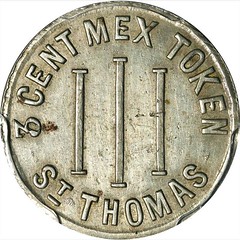 "Regarding the 3-cent token and its mysterious MEX inscription, that may be an abbreviation for "medium of exchange." It's just a guess on my part."
"Regarding the 3-cent token and its mysterious MEX inscription, that may be an abbreviation for "medium of exchange." It's just a guess on my part."
Hmmm. Could be, I guess. Better than any of my guesses (I didn't really have any). Other thoughts, anyone? -Editor
To read the earlier E-Sylum article, see:
NUMISMATIC NUGGETS: AUGUST 14, 2022 : 1890 Danish West Indies 3 Cent Mex Token
(https://www.coinbooks.org/v25/esylum_v25n33a23.html)
Numismatic Poet Society's 2022 Award
"Caleb Black has received the Numismatic Poet Society's 2022 award for Best Original Poem in a Numismatic Exhibit
at the Georgia Numismatic Association Show. The award is a 2022 Proof American Silver Eagle in a Congratulations Set. Caleb is a Young Numismatist member of several organizations and a regular contributor to the ANA Member Blog. He has also exhibited, attended and paged at regional coin shows. The Award was Presented by John Phipps, founding member of the NPS. Also in the picture is Tom Youngblood, president of the GNA
His poem is a haiku related to his interest in Chinese Silver Panda. Here is his winning poem.
Panda Coin Haiku by Caleb Black
Chinese panda coins
never fail to impress me
forty years minted
"The Numismatic Poets Society was started in 2012. A lifetime membership is available to any poet that writes and submits an original numismatic related poem and agrees to let it be distributed to all members. Membership is currently at 10 poets."
I like it. Congratulations. -Editor
To read an earlier E-Sylum article, see:
NUMISMATIC POETS SOCIETY AWARD
(https://www.coinbooks.org/v21/esylum_v21n16a22.html)
On Indian Peace Medal Provenance
"In the August 14 E-Sylum, Nathan Markowitz wrote about Indian Peace Medals and how the provenance info is difficult to obtain. I found this true when writing an article "Indian Peace Medals... did they help keep the peace?" in the Summer 2022 issue of The California Numismatist. I described (all?) 30 IPMs, and found the story of Chief Honkapkna's IPM especially interesting.
"I had described that medal this way: "Another remarkable example of the 1862 President Lincoln medal is in the collection of the American Numismatic Society. This piece has a bullet embedded in its reverse, and is said to have belonged to the Ute Indian chief Honkapkna, who probably received it in 1864 after a series of treaties created a reservation for the Ute tribe in what is now Utah. The chief had been shot in battle, probably in the Black Hawk War (1865–1872), but the medal saved his life by preventing the bullet from penetrating his body.
Nevertheless, Honkapkna reputedly sold the medal in disgust in 1872 in its present condition because he had expected its medicine
to have completely shielded him from harm. In this case, perhaps a Peace Medal saved at least one life."
"Another famous medal was the Chief "Three Fingers" engraving on a Benjamin Harrison IPM, undated but struck around 1890, the last of the original IPM series. This medal was originally presented to Chief Buffalo Meat of the Southern Cheyenne. It eventually became the property of Buffalo Meat's contemporary Chief Three Fingers. The eradicated name "Buffalo Meat" cold be partially read at the place where Three Fingers' name was then added. The medal was reportedly later acquired in a yard sale. (Provenance known, then lost!)
"Here is the Three Fingers medal reverse, and a photo of the chief wearing it."
To read the earlier E-Sylum article, see:
THE CHIEF THREE FINGERS MEDAL
(https://www.coinbooks.org/esylum_v17n45a18.html)
MORE ON THE CHIEF THREE FINGERS INDIAN PEACE MEDAL
(https://www.coinbooks.org/esylum_v17n46a17.html)
NOTES FROM E-SYLUM READERS: AUGUST 14, 2022 : On Indian Peace Medal Recipients
(https://www.coinbooks.org/v25/esylum_v25n33a11.html)
Coin Dies Used In 1922
Steve Shupe writes:
"As to the dies used in 1922 this is the information from the Mint report. Probably not enough detail, but I thought I would still share."
Thank you. -Editor
To read the earlier E-Sylum article, see:
NOTES FROM E-SYLUM READERS: AUGUST 14, 2022 : 1922 U.S. Mint Die Records Sought
(https://www.coinbooks.org/v25/esylum_v25n33a11.html)
August Moyaux Sale Catalogue Sought
David Pickup writes:
"Would any of your readers have a copy of a sale catalogue 110 by a Belgian firm called Charles Dupriez who sold the August Moyaux collection? I am trying to research Captain Ernest Swan who had an extensive railway medallion collection."
Can anyone help? -Editor
More on the Reakirt Famous Old Collection
Julia Casey writes:
"I searched the NNP for Reakirt and I found this terrific write up of the rare sale catalog in the 19th mail bid sale of numismatic literature by The Money Tree (Rocky River, Ohio)."
Thank you! -Editor
To read the earlier E-Sylum article, see:
NOTES FROM E-SYLUM READERS: AUGUST 7, 2022 : More on the 1963 "Famous Old Collection"
(https://www.coinbooks.org/v25/esylum_v25n32a16.html)
NOTES FROM E-SYLUM READERS: AUGUST 14, 2022 : More on the Joseph Reakirt Collection
(https://www.coinbooks.org/v25/esylum_v25n33a11.html)
THE TRILOBITE COINS OF VERMONT
Julia Casey recently learned about a private coin in Vermont. -Editor
The Trilobites of West Rutland, Vermont
Julia writes:
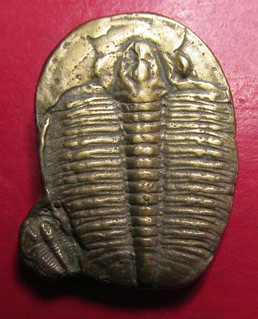 "I recently spoke at the Dorset Historical Society about my research into the Crane Ring of counterfeiters in Rupert, Vermont. One of the attendees was Glenn Campbell, a talented artist who runs the Campbell Plaster & Iron foundry in West Rutland. Glenn had some interesting perspectives on 18th century cast counterfeit coins, which came from his years of experience in working with molten metals.
"I recently spoke at the Dorset Historical Society about my research into the Crane Ring of counterfeiters in Rupert, Vermont. One of the attendees was Glenn Campbell, a talented artist who runs the Campbell Plaster & Iron foundry in West Rutland. Glenn had some interesting perspectives on 18th century cast counterfeit coins, which came from his years of experience in working with molten metals.
"He also gave me, for free, this terrific Trilobite
that he had made! It is about 28mm x 20mm and weighs 10.6g. There is no legend or denomination. Glenn has a neat little experiment where he hands out these beauties and tells people to value it as they please.
He leaves it up to the local community to put them into barter commerce for goods and services. Though I won't be doing that with mine as it is a definite keeper
and a lovely souvenir of my day in Dorset!"
Thanks! This naturally reminds the numismatist of the private issue in nearby Connecticut circa 1737-1739 - the Higley Coppers, some with the legend "Value Me As You Please." -Editor
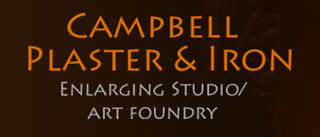 For more information on Campbell Plaster & Iron, see:
For more information on Campbell Plaster & Iron, see:
https://cpisculpture.com/
For more information on trilobites, see:
Trilobite
(https://en.wikipedia.org/wiki/Trilobite)
Vermont Trilobite
(http://www.thefossilforum.com/index.php?/topic/72428-vermont-trilobite/)
To read earlier E-Sylum articles, see:
ARTICLE HIGHLIGHTS HIGLEY COPPERS
(https://www.coinbooks.org/esylum_v16n14a18.html)
PHILADELPHIA BANK BUILDING COIN SCULPTURES
(https://www.coinbooks.org/v25/esylum_v25n16a07.html)
RANGER INDUSTRIES
Like many of us, I'm on the receiving end of a lot of numismatic marketing emails. Most go straight to spam or trash, but sometimes one sticks out. Gene Frink's Ranger Industries started out creating military insignias and challenge coins, but now offers a range of custom coin and medal products. At my request the company provided the following profile and images of some of their numismatic medal work. -Editor
An expression of appreciation, camaraderie, and accomplishment
Ranger Industries is an industry leading resource for high quality Emblematic, Medallic and Custom Award & Recognition products, with offshore options that also provide cost-conscious solutions to meet your budget requirements.
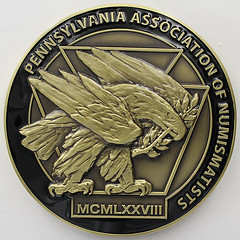 Ranger Industries, founded in 2016, originated in the 1980s, when then PFC Gene D. Frink designed a pocket patch for his Army unit, B Co., 2nd Bn 75th Infantry Rangers, Airborne. After completing his tenure of service, Gene started DeVere Enterprises, and branched out into making custom minted Challenge Coins. After several decades in the business, Army Contractor as a recruiter after 9/11, and his return to the industry with SOCOM Industries, later becoming Ranger Industries, LLC., Gene would establish a team of professionals with more than 100 years of combined custom minting experience.
Ranger Industries, founded in 2016, originated in the 1980s, when then PFC Gene D. Frink designed a pocket patch for his Army unit, B Co., 2nd Bn 75th Infantry Rangers, Airborne. After completing his tenure of service, Gene started DeVere Enterprises, and branched out into making custom minted Challenge Coins. After several decades in the business, Army Contractor as a recruiter after 9/11, and his return to the industry with SOCOM Industries, later becoming Ranger Industries, LLC., Gene would establish a team of professionals with more than 100 years of combined custom minting experience.
Our company's core capabilities are centric to custom designed Challenge Coins, Commemorative Coins, Award Medals, Medallions, Lapel Pins and Patches. Ranger Industries is also a great resource for custom Personalized Achievement Awards. With these core product capabilities, we work through the full spectrum of metal alloys such as Brass, Bronze, Nickel, Zinc, Steel, and precious metals such as .999-fine Silver and Gold.
Businesses, military units, government agencies, clubs, first responders, associations, municipalities and individuals from all over the United States and beyond trust Ranger Industries, LLC. to provide original die struck and metal cast expressions of appreciation and celebration that are certain to be treasured for a lifetime. We can accomplish your objective, provide helpful creative assistance, meet your budget and help you recognize achievement and build esprit de corps.
Contact us today to receive a FREE, no-obligation quote for your project! And make sure to browse our new Online Store that has over 2,500 retail items available - with more added weekly!
For more information, see:
http://www.rangercoin.com/
VOCABULARY TERM: LIMITING GUIDE
Here's another entry from Dick Johnson's Encyclopedia of Coin and Medal Terminology. I added token images from the website of dealer Steve Hayden. -Editor
Limiting Guide. A design element on a medallic piece to position additional work, as the focus to drill a hole, or for piercing; to affix a foot or hanger; to apply a jewel or appliqué, or such.
A few 19th century medals had tiny raised circles as limiting guides or piercing guides for drilling a hole at the 12:00 position just inside the rim. These can be found on several early U.S. Mint Indian Peace Medals, including James Madison (IP-5) and John Tyler (IP-21) Indian Peace Medals. Also a number of hand engraved medals by J.E. Eyman for the American Methodism Centenary, 1866, had limiting guides, some on both sides.
Limiting guides disappear if the hole drilled is larger than the diameter of the circle. However some specimens are found intact without the hole drilled. Hence they indicate a scarce variety of the piece since most such medals were intended to be issued holed (and usually are so). The raised circle's shape is called an annulet (but "limiting guide" when intended to have some further work done).
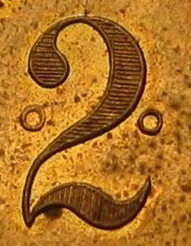 Another interesting example is the enigmatic diestruck token collectors call Contrahendo et Solvendo (Rulau Y3). It bears limiting guides, on either side of a large 2. It is speculated the pieces are intended to be suspender buttons and the two holes are for sewing to a garment!
Another interesting example is the enigmatic diestruck token collectors call Contrahendo et Solvendo (Rulau Y3). It bears limiting guides, on either side of a large 2. It is speculated the pieces are intended to be suspender buttons and the two holes are for sewing to a garment!
Sometimes an incuse limiting guide was employed, as where a gemstone was to be set in. An example is the American Numismatic Association Chicago Convention Medal of 1966, where a diamond was inset. Limiting guides found on the reverse of a uniface piece generally indicate some form of mounting to be attached. Paperweight plaquettes with half ball feet frequently had limiting guides struck as raised circles where the feet were to be attached. The hemisphere fits within the raised circle, which acted as a tiny fence around the feet.
In very rare instances the diesinker or medal designer would allow for spacing in the legend near the rim (without the limiting guide). An example is a Stephen A. Douglas Medal of 1866; the word monument contained space indicating where a hole is to be drilled, thusly: monu [space] ment.
Reference:
{1999} Rulau (Russell) Standard Catalog of United States Tokens, 1700-1900, p 321-322.
To read the complete entry on the Newman Numismatic Portal, see:
Limiting Guide
(https://nnp.wustl.edu/library/dictionarydetail/516235)
To read the complete lot description, see:
638 - RULAU Y3C Raw MS63 1857 Non-Local Merchant token
(75-100)
(https://www.civilwartokens.com/Event/LotDetails/2685739/638-RULAU-Y3C-Raw-MS63-1857-NonLocal-Merchant-token)
WILLIAM WETMORE'S TRAVELING DESK
Dave Fegley submitted these biographical notes on collector William Wetmore and photos of Wetmore's traveling desk, which Dave found recently at the antique arms show in Allentown PA. Cool item! -Editor
6th CAV
December 7, 1849 - March 24 1919
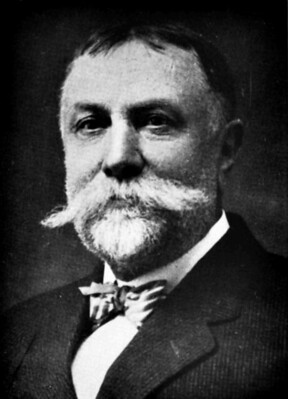 William Wetmore was born in New York on December 7, 1849
to Samuel Wetmore and Sarah Boerum. Great-great-grandson of
Capt. William Boerum, of Revolutionary Army; Great-grandson of
Col. Jackson Browne, of British Colonial Army, who served in the
Barbadoes, W. I.; Grandson of Capt. William Boerum, U. S. N. in
battles of Hornet and Peacock; Hornet and Penguin.
William Wetmore was born in New York on December 7, 1849
to Samuel Wetmore and Sarah Boerum. Great-great-grandson of
Capt. William Boerum, of Revolutionary Army; Great-grandson of
Col. Jackson Browne, of British Colonial Army, who served in the
Barbadoes, W. I.; Grandson of Capt. William Boerum, U. S. N. in
battles of Hornet and Peacock; Hornet and Penguin.
Cadet at West Point Military Academy, July 1, 1867, to June 14, 1872, when he graduated and was promoted in the Army to Second Lieutenant 6th Cavalry.
He served at the Military Academy as Assistant Instructor of Ordnance and Gunnery, July 5-29, 1872, and of Field Telegraphing, July 29 to Aug. 31, 1872; on graduation leave of absence, Aug. 31 to Dec. 12, 1872; on frontier duty at Fort Reilly Kansas, Dec. 13, 1872, to Feb. 1, 1873,; Fort Wallace Kansas to July 10, 1873, — and at River Bend, Colorado to Oct. 3, 1873, being engaged on Sep. 10, 1873 in a hand-to-hand encounter with a band of desperadoes attempting to rob the Paymaster, he shot the chief of whom was the notorious ex Captain Graham; as Aide-de-camp to Bvt. Major-General Pope Oct. 3, 1873, to Sep. 4, 1875, at Headquarters of Fort Leavenworth Kansas as Acting Aide-de-Camp, Aug. 1 to Dec. 1, 1874, to Bvt. Major- General Miles, commanding Expedition to Indian Territory, being engaged, Aug. 30, 1874, in the Action of Red River, for which he was recommended to be brevetted First Lieutenant and Captain; on leave of absence, to make a tour around the world, Sep. 4, 1875, to Oct. 4, 1876. - Resigned, Dec. 1, 1876.
Major, New York Militia, 1879-82. Delegate to Democratic Convention at St. Louis, Mo., to nominate a candidate for the Presidency, 1888.
His marriage to Annette Butler in 1882 resulted in divorce and made the society papers in 1892 complete with allegations of gambling and other unpleasantness.
His second marriage was to Katherine Havercamp.
He raised in Philadelphia, Pa., and vicinity, the "Wetmore Regiment of Pennsylvania Volunteers," for the Spanish-American war, but finally had to disband it, as preference was given to the National Guard, who filled up the entire quota of the State. On the outbreak of the war with Spain, he offered his services to the government for any position to which they might choose to assign him. Friends wanted him to raise his regiment from Rhode Island and Fall River, but finding the State's quota full, he decided to raise one in Pennsylvania. He opened a recruiting office, all his men being physically examined, and had a regiment ready to go to the war, but unfortunately Pennsylvania's quota was at this time also full, and finding it impossible to get to the front, he got as many of his men as possible to join vacancies in other Pennsylvania regiments, even sending two companies to fill up one that was short. He then offered to take command of a battalion of troops in one regiment and put his men in, and it was accepted, but it was found the State's quota was full.
Throughout his life he was an avid coin collector and went on to
be a noted numismatist assembling one of the great collections
of early US coins and sold by S. H. & H. Chapman in 1906.
The catalog of his sale is reprinted to this day and included the
famous Cohen
specimen of the 1804 dollar.
Some of his correspondence with S. H. Chapman is in the archive collection of the American Numismatic Society. He was friends with John Work Garrett who requested President Andrew Johnson recommend his admission to West Point.
A December 23, 1878 letter from Major William Wetmore to S.H. Chapman from the ANS archives concerning the use of the metric system to measure coins.
Retired Major Wetmore was a member of the U. S. Military Service Institute; U. S. Naval Institute; U. S. Cavalry Association; American Numismatic Society, New York; National Academy of Design, New York; American Geographical Society, N. Y.; Chamber of Commerce, N. Y.; American Metropolitan Museum of Art, New York; New England Society, New York; Order of the Cincinnati; Order of Society of War of 1812; Naval Order of United States; Order of Veterans of Indian Wars of the United States.
- He died on March 24, 1919 in Atlantic City, New Jersey -
Major William Boerum Wetmore 1870s traveling desk as found at antique arms show in Allentown, Pa. Believed to be a gift from his mother at his graduation from West Point in 1872.
Dave adds:
"It was a bit out of this poor guy's budget, but way too cool to leave to obscurity. I was about halfway home from that show when it struck me who (Major - not Lieutenant) Wetmore was. I turned around and drove 60 miles back to get it.
"It really is beautiful even after 150 years. The (aged) owner had bought it at the Baltimore Antique Antique Arms Show in the early 80s. He didn't know who Wetmore was other than serving in the 6th Cav. This is the first it will be presented with proper identification."
Thanks! Great association item. Wetmore's metric scale is akin to the Collet and Kolit scales discussed by Pete Smith last week. -Editor
To read the earlier E-Sylum article, see:
THE COLLET AND KOLIT SCALES
(https://www.coinbooks.org/v25/esylum_v25n33a17.html)
ANS ANNOUNCES RESOLUTE AMERICANA CHAIR
This news came out earlier this month, but I wanted to make sure we covered it here. The ANS has a new endowment to support curatorship in American numismatics. -Editor
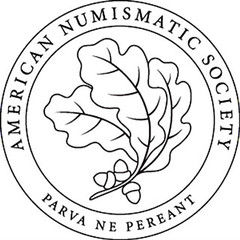 The American Numismatic Society (ANS) is pleased to announce the naming of the curatorial position in American numismatics as the Resolute Americana Chair of American Numismatics. Thanks to a generous donation by ANS Life Fellow Robert L. Rodriguez, a longtime researcher and collector of Colonial and early United States coinage, the endowment to support this curatorship has now grown substantially.
The American Numismatic Society (ANS) is pleased to announce the naming of the curatorial position in American numismatics as the Resolute Americana Chair of American Numismatics. Thanks to a generous donation by ANS Life Fellow Robert L. Rodriguez, a longtime researcher and collector of Colonial and early United States coinage, the endowment to support this curatorship has now grown substantially.
The chair's new name honors one of Mr. Rodriguez's outstanding achievements, the assemblage of his Resolute Americana Collection, which includes coins and medals ranging from the beginning of the colonial period in the Americas to the earliest days of the United States Mint. Notable among them are some of the finest examples of Massachusetts silver coinage from 1652, the most complete collection of Continental dollars, and among the finest sets of 1792 mint pattern coinage ever assembled. Mr. Rodriguez chose the name Resolute
for several reasons, among them his belief that the word aptly describes his own personal nature. He noted that the name also evokes the HMS Resolute, a British ship that has its own unique ties to American history.
The Resolute Americana Chair of American Numismatics supports the work of the curator overseeing the Society's collection of North American and Latin American coins, tokens, and paper currency, as well as portions of the collection of medals. With nearly 200,000 objects dating from the early sixteenth century to the present, the Society's American holdings represent one of the premier collections of American-related numismatics in the world.
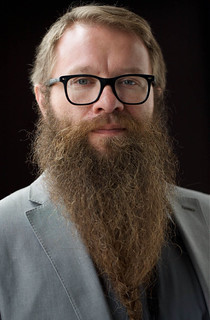 Assistant Curator Dr. Jesse Kraft holds this endowed chair. Dr. Kraft, who completed his Ph.D. in United States History from the University of Delaware in 2019, has become acknowledged as an expert in the field of American numismatics. He has published extensively in both the Journal of Early American Numismatics, where he currently serves on the Editorial Committee, and the ANS Magazine; his forthcoming monograph, Colonial Change: The Circulation and Rejection of Foreign Coinage in the United States, ca. 1600–1900, will be published in 2023.
Assistant Curator Dr. Jesse Kraft holds this endowed chair. Dr. Kraft, who completed his Ph.D. in United States History from the University of Delaware in 2019, has become acknowledged as an expert in the field of American numismatics. He has published extensively in both the Journal of Early American Numismatics, where he currently serves on the Editorial Committee, and the ANS Magazine; his forthcoming monograph, Colonial Change: The Circulation and Rejection of Foreign Coinage in the United States, ca. 1600–1900, will be published in 2023.
We are very grateful for this contribution from Mr. Rodriguez, who has been extraordinarily generous in his support of the research and publication of American numismatics at the ANS,
said Executive Director Gilles Bransbourg. We are pleased that this gift recognizes the quality of the collection of American numismatics here and ensures that research in this area will continue to expand and deepen.
Many thanks to Rob Rodriguez for this generous donation, which will enable continued research and publication in this important and still perplexing area. -Editor
To read the complete article, see:
ANS Announces Resolute Americana Chair of American Numismatics
(https://numismatics.org/resoluteamericana/)
NAC AND SHANNA SCHMIDT FORM NAC USA
This press release details the new partnership between Numismatica Ars Classica and longtime E-Sylum supporter Shanna Schmidt. -Editor
With the founding of NAC USA, Numismatica Ars Classica and Shanna Schmidt are forming a strategic partnership to improve NAC's services for American customers. Thanks to NAC USA, American customers can buy and sell via NAC as though the European auction house were located in the United States.
Anyone who's interested in high-quality ancient and Italian coins will be familiar with the auction house Numismatica Ars Classica (NAC) located in London, Zurich and Milan. It is one of the world's most important auction houses, especially when it comes to high quality ancient and Italian coins. Here's a good example to illustrate this: NAC is responsible for seven of the ten best results ever achieved for Roman gold coins at auction.
Originally based in Naples, the company's founder Roberto Russo decided to relocate to the Swiss city of Zurich, which was the center of the international coin trade at the time. A decade ago, NAC opened its London office. Now, his sons Arturo and Giuliano Russo are going a step further: they are founding an additional NAC location in Chicago. And as a partner, they've secured one of the best-known and most creative personalities in the American trade in ancient coins: Shanna Schmidt.
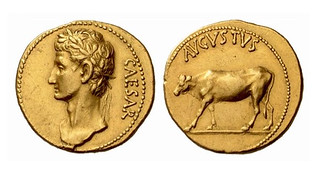 From a very young age, Shanna Schmidt has known the world of numismatics inside out, and
she's been working in the coin trade for several decades. She also has an academic
background. Her Master's thesis covered the cultural property debate, with a particular focus
on ancient coins. Shanna Schmidt has been working as an independent coin dealer in Chicago
since 2016. She has excellent connections and represents some of America's most prominent
collectors at auctions around the world.
Shanna Schmidt is committed to a vision: she wants to bring the European and American
markets closer together. You might say that she was predestined to follow this path: after all,
in addition to her first language, she also speaks fluent German.
From a very young age, Shanna Schmidt has known the world of numismatics inside out, and
she's been working in the coin trade for several decades. She also has an academic
background. Her Master's thesis covered the cultural property debate, with a particular focus
on ancient coins. Shanna Schmidt has been working as an independent coin dealer in Chicago
since 2016. She has excellent connections and represents some of America's most prominent
collectors at auctions around the world.
Shanna Schmidt is committed to a vision: she wants to bring the European and American
markets closer together. You might say that she was predestined to follow this path: after all,
in addition to her first language, she also speaks fluent German.
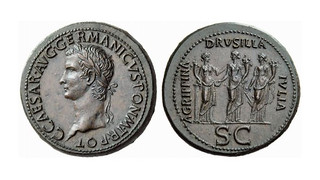 Together, Numismatica Ars Classica and Shanna Schmidt have developed a concept that will
offer American customers a whole new dimension of service. Consigning coins to and buying
them from NAC will be as easy as doing business with a U.S. company. There are no longer
any problems with money transfers or customs formalities. NAC USA organizes everything
for the customer. Payments can be made in dollars within the USA. The coins are sent straight
to the customer from Chicago. NAC USA enables customers to purchase coins in auctions in
Europe, while at the same time enjoying the service of an American company. The same
applies to consignors. They have the option of consigning their coins for NAC floor auctions
and the NAC's online format Naville straight to Shanna Schmidt in the USA – whether at a
coin fair or at the NAC premises. NAC USA will take care of all formalities and practical
arrangements for consigners. This makes it much easier for customers in the USA to consign
to one of the most successful auction houses in Europe, which has an extremely affluent
clientele.
Together, Numismatica Ars Classica and Shanna Schmidt have developed a concept that will
offer American customers a whole new dimension of service. Consigning coins to and buying
them from NAC will be as easy as doing business with a U.S. company. There are no longer
any problems with money transfers or customs formalities. NAC USA organizes everything
for the customer. Payments can be made in dollars within the USA. The coins are sent straight
to the customer from Chicago. NAC USA enables customers to purchase coins in auctions in
Europe, while at the same time enjoying the service of an American company. The same
applies to consignors. They have the option of consigning their coins for NAC floor auctions
and the NAC's online format Naville straight to Shanna Schmidt in the USA – whether at a
coin fair or at the NAC premises. NAC USA will take care of all formalities and practical
arrangements for consigners. This makes it much easier for customers in the USA to consign
to one of the most successful auction houses in Europe, which has an extremely affluent
clientele.
NAC USA will be opening its own gallery in October. It will be offering customers coins at fixed prices, from both NAC's and Shanna Schmidt's stock. Moreover, NAC USA will be present at most major coin shows in the U.S. in order to get in touch with collectors all over the country. Shanna Schmidt will share her extensive expertise, in order to assist collectors in making the most of their budget when buying and the most of their collection when consigning.
NAC USA combines the best of the American and European coin trade.
NAC USA
8 South Michigan Ave
Suite 3600
Chicago, IL 60601
Tel: +1 (312) 883-8541
shannaschmidt@arsclassicacoins.com
The gallery will be opened in October 2022. Office and gallery are open on appointment only.
For more information, see:
https://www.arsclassicacoins.com/
STACK'S BOWERS SUMMER 2022 AUCTIONS
This press release summarizes the various collections and offerings in the Stack's Bowers Galleries Summer 2022 Global Showcase Auctions. -Editor
Stack's Bowers Galleries is thrilled to present an exceptional selection of United States coins
and Numismatic Americana in their Summer 2022 Global Showcase Auction. This will be remembered as a historic
milestone in numismatics, highlighted by the finest known Proof 1825/4/1 half eagle offered as part of the Mocatta
Collection. Graded Proof-67 Cameo (PCGS) CAC, this specimen is one of just three known and can be traced to
before 1864, through the cabinets of such luminaries as Parmelee, Eliasberg and King Farouk of Egypt. It is
accompanied in the Mocatta Collection by numerous other rarities including a pair of 1796 Stars and No Stars $2.50
quarter eagles, a lovely 1879 Flowing Hair $4 Stella, Wire Rim and Rolled Rim Pattern
1907 Indian $10 pieces, a
Gem Proof 1887 Liberty Head $20, and many others.
A truly astounding selection is offered from the legendary Cardinal Collection Educational Foundation. Famous for its focus on top-quality Early American coins and medals, this selection is anchored by an incredible 1792 Copper Disme that was once in the collection of Dr. J. Hewitt Judd. Graded SP-62 BN (PCGS) CAC, it is the second finest known and can be traced back to before 1908. Also offered from the Cardinal Collection is the famous Charles Jay 1793 Sheldon-14 Liberty Cap cent which ranks as the finest known at AU-53+ (PCGS), and an important Specimen- 62 (PCGS) 1826 Erie Canal Completion Medal in silver, HK-1000 variety.
The inaugural offering from the Sydney F. Martin Collection is presented in a meticulously researched, stand-alone
catalog featuring over 260 coins and medals. Included are his front-line collections of New Jersey coppers and
Massachusetts coppers, both among the finest holdings in these series ever assembled. The collection contains 113
of 145 confirmed die pairings of New Jersey coppers including major rarities such as the 1786 Maris 9-G No
Coulter
variety graded PCGS VF-30, as well as superb quality pieces like the 1786 Maris 21-N graded PCGS MS-65+ Red-Brown, one of the very finest known New Jersey coppers of any variety. The Massachusetts half cents and
cents dated 1787 and 1788 are even more complete, as Martin gathered 46 of the 51 known die pairings in the series.
Rounding out this initial auction are incredible offerings of Saint Patrick coinage, Higley coppers, Pitt tokens, Rhode
Island ship medals, and Libertas Americana medals.
Stack's Bowers Galleries is honored to present a historic selection of 35th Anniversary American Eagle Gold and Silver coins on behalf of the United States Mint. Offered are the final 500 each of the classic American Eagle gold and silver 1 ounce coins and the first 500 coins each of the new American Eagle gold and silver 1 ounce coins. Deemed the American Eagle At Dawn and At Dusk Coins, these coins were produced in a special striking ceremony under the guidance of former Director of the Mint David Ryder and will be offered exclusively in the Stack's Bowers Galleries Summer 2022 Auction. In recognition of this historic offering, the auction firm will also waive the Buyer's Premium on these 35th Anniversary coins, meaning that the highest bid on each lot (the hammer price) will be the final amount paid by the winning bidder, excluding shipping fees. These 35th Anniversary coins are also exempt from sales tax, which should encourage even stronger bidding from collectors!
The incredible JBR Set of Gold Coins from the Fairmont Collection is a landmark feature of the Summer 2022 Global Showcase Auction. Comprising nearly complete runs of the $5, $10, and $20 denominations beginning in 1834, the JBR Set exhibits an astounding combination of Condition Census and Everyman quality across the rarest dates and varieties of U.S. gold. The 554 coins in the set feature an overall CAC approval rate of 63% and rank among the top PCGS Registry Sets in their respective categories. Highlights include an 1864-S $5 graded EF-45 (PCGS) CAC, an 1853/'2' $10 graded MS-62 (PCGS) CAC, and a monumental selection of Liberty Head $20s led by an 1861-O graded AU-55+ (PCGS) CAC, an 1866-S No Motto graded AU-58 (PCGS), and an 1885-CC graded MS-62 (PCGS) CAC.
One of the most significant collections of Classic Head gold coinage ever formed – the Virginian Collection – was assembled by Daryl J. Haynor and includes some of the finest Classic Head quarter eagles and half eagles known. The cabinet features Condition Census examples of the 1838-C, 1839-C and 1839-O quarter eagles and both the HM-1 and HM-2 varieties of the historic 1838-C half eagle. Virtually all die varieties among circulation strike issues in this series are represented, including the rare 1835 HM-5 and 1836 HM-9 half eagles.
The Georgia Gold Rush Collection, offered by the John O. Sykes Family, represents a pinnacle of numismatic achievement for the Dahlonega Mint gold series. Containing a complete date and major variety set of the coinage of this branch mint, it also includes multiple examples of many issues. The result is that among the 150 coins that comprise this outstanding collection can be found famous Condition Census rarities in Choice and Gem Mint State alongside more affordable, yet still scarce and highly desirable coins in EF and AU grades. Highlights include an 1861-D gold dollar graded MS-63 (PCGS) CAC, an 1861-D Liberty Head half eagle graded MS-63 (PCGS), and an 1854-D three-dollar gold piece graded MS-62 (PCGS) CAC.
The Augustana Collection contains thousands of coins from around the world accumulated over nearly five decades. The goal of the collection was to portray human progress over the last few centuries. The United States coins featured in the sale span from the extinct Charlotte and Dahlonega mints to the work of Augustus Saint-Gaudens, reflecting America's emergence on the world stage. Highlights include an 1844-C Liberty Head half eagle graded MS-62+ (PCGS), a MS-64 (PCGS) CAC 1907 High Relief, Wire Rim Saint-Gaudens $20, and a MS-62 (PCGS) Octagonal 1915-S Panama-Pacific Exposition $50.
The Andrew M. Hain Collection is a provenance that requires no introduction among seasoned numismatists. It is most famously associated with a captivating selection of Massachusetts Silver coins and other Early American rarities that were offered in Stack's January 2002 auction. Over two decades later, Stack's Bowers Galleries is delighted to present another magnificent selection from this cabinet in the Summer 2022 sale. The core of this offering is a delightful group of early gold coins that have been off the market for many years, highlighted by such treasures as a MS-62 (PCGS) 1802/'1' Capped Bust Right quarter eagle, an AU-53 (PCGS) OGH 1797 Heraldic Eagle Capped Bust Right $10, and an AU-58 (PCGS) OGH 1803 Capped Bust Right eagle.
The Jones Collection is a wide-ranging cabinet of rarities spanning from the very earliest American issues to the
renaissance of U.S. coinage in the early 20 th century. It is highlighted by a magnificent MS-65 (PCGS) 1776"
Continental Dollar, a Proof-64 (PCGS) CAC 1895 Morgan dollar, and an EF-40 (PCGS) CAC 1855 Wass, Molitor
& Co. $50.
The Madrone Collection is an impressive selection of Territorial and other gold rarities that includes such treasures as a pair of AU-53 (PCGS) 1851 Augustus Humbert Lettered Edge $50 coins (the 880 THOUS and 887 THOUS types) and a pair of MS-65 (NGC) 1915-S Panama-Pacific Exposition $50 coins (Round and Octagonal varieties). The Pacific Rim Collection offers an important selection of Proof silver dollars including such rarities as a 1921-S Zerbe Special Strike Morgan in Specimen-65 (PCGS), a Proof-65 Cameo (PCGS) CAC 1876 Trade dollar, and a Proof-66 Ultra Cameo (NGC) 1896 Morgan.
An exciting selection of Bitcoins and other Physical Cryptocurrency is presented at the end of the Rarities Night
Session. This category has been earning incredibly strong premiums among traditional coin collectors and crypto
enthusiasts alike. This selection is highlighted by an extremely rare 2011 Casascius 1 BTC DOUBLE ERROR
variety graded MS-66 (PCGS) that is one of just five known, as well as an impressive 2012 Casascius 5 BTC
Bitnickel
graded MS-65 (PCGS).
Beyond these curated selections of U.S. coins, numerous individual rarities can be found in the Summer Global Showcase Auction, including a historic ca. 1777 Philip Syng, Jr. Regulated Bolivian 8 Reales graded VF-25 (NGC), a flawless MS-68 RD (PCGS) 1902 Indian cent, a MS-66 FH 1926-D Standing Liberty quarter, the unique Proof 1829 half dollar graded Proof-66 (NGC), a possible specimen striking 1839-C Liberty Head half eagle graded MS-64 (PCGS), a near-Mint AU-58 (PCGS) 1861-O Liberty Head double eagle, and a world-class 1878 Pattern quarter eagle, Judd-1566 graded Proof-67 Cameo (PCGS).
Passionate collectors of Numismatic Americana will delight in a historic offering from the Collection of Paul A. Volcker, Jr., who served as the 12th Chairman of the Federal Reserve from 1979 to 1987. In a career spanning nearly six decades including public service under five U.S. presidents, Volcker worked for private and public firms as an esteemed economist and helped shape the nation's economic policies. This selection from the Volcker Collection is highlighted by an impressive 96 mm Benjamin F. Fairless Memorial Medal in Gold and a historic Nelson A. Rockefeller Public Service Award Gold Medal.
Additional rarities among the Numismatic Americana include a historic AU-58 BN (NGC) "1781" Libertas Americana Medal in Bronze, a ca. 1790s signed sketch by Augustin Dupre (designer of the Libertas Americana medal), and an 1825 John Quincy Adams Indian Peace Medal in silver.
The entire Summer 2022 Global Showcase Auction is now available for pre-bidding at www.StacksBowers.com. Live bidding will take place from August 22 through September 1, hosted from Griffin Studios, Stack's Bowers Galleries' state-of-the-art auction venue in Costa Mesa, California. For questions about any lots in the Summer 2022 sale or to consign your collection to the future event, contact Stack's Bowers Galleries at Consign@StacksBowers.com or 800-566-2580.
STACK'S BOWERS SUMMER 2022 U.S. CURRENCY
Another press release summarizes U.S. currency offerings in the Stacks Bowers 2022 Summer Global Showcase Auction. Some great notes here. -Editor
Stacks Bowers Galleries is thrilled to present an important offering of United States Currency in their Summer Global Showcase Auction. The firm's first showcase currency sale since their Spring 2022 Auction, it features many rarities and advanced collections. Given the strong prices realized in their Spring 2022 Auction, another record-breaking sale is anticipated.
One notable cabinet is the Boston Proper Collection
of large size Federal Reserve Bank Notes and Federal
Reserve Notes from the Boston district. Highlights include lot 20330, a Fr. 1132-A 1918 $500 in PMG Very Fine 25
(one of just three known), and lot 20262, a Fr. 781* 1918 $5 FRBN replacement graded PMG Very Fine 30 (one of
just two known).
The Summer 2022 Auction will also present The Mismacthed Serial Number Collection.
Built over decades, this
offering features the most extensive and comprehensive collection of mismatched serial numbers ever assembled.
Among the key notes being offered from this group are lot 20529, an 1869 $1 Legal Tender note, lot 20530, an 1899
$1 Silver Certificate, and lot 20531, the famous 1929 $100 National Bank Note from Dayton, Ohio.
The standout highlight of the sale is lot 20126, a Fr. 172 1880 $100 Legal Tender Note in PMG 65EPQ. Other important offerings include lot 20188, an 1886 $10 Silver Certificate graded Gem 65PPQ by PCGS Banknote, lot 20510, a 1928 $500 Gold Certificate in PCGS Banknote 63, and lot 20437, a stunning 1928 $500 from St. Louis in a PMG 66EPQ holder.
The entire Summer 2022 Global Showcase Auction is available for viewing and bidding at the firm's website StacksBowers.com. For more information regarding these offerings, to inquire about bidding, or to consign to a Stack's Bowers Galleries Auction, please contact PeterT@StacksBowers.com.
MORE FEISEL AUGUST 2022 TOKEN HIGHLIGHTS
Here's another announcement with highlights from the upcoming token sale from Duane Feisel, closing on August 28, 2022. He can be reached at dhfeisel@frontier.com . -Editor
Bidding on the auction has picked up substantially by the delivery of the print version of "Talkin' Tokens," the monthly publication of the National Token Collectors Association (NTCA). Increased viewing activity of some of the auction lots has also been noted on the photo hosting site accessible at:
https://collector-ca.smugmug.com/Tokens-Exonumia/2022-AUGUST-MAIL-BID-SALE/
And as a reminder, when submitting your bids be sure to use the lot number rather than the image number from this site.
Should still need a full listing of the auction lots, please let me know and I'll send you a PDF color copy.
If you have not yet submitted your bids, now is the time to do so!
This auction offers a wide variety of better exonumia items including:
Lot 3: THE / BREWERY / SALOON / ALTURAS // Good For / 1 / Drink, br rd 21mm. Listed 2F-2 $500/1,000. G3-MB$600
Lot 30: ECKERTS / SALOON / MAGALIA, / CAL. // Good For / One / Drink, br rd 21mm. Listed 2F-1 $250/500. G3-MB$550
Lot 62: MANHATTAN SALOON / 248 / SOUTH / SAN JOAQUIN / STREET / STOCKTON. / CAL. // Good For / 10¢ / In / Trade / (sm: C.A. Klinkner & Co. S.F.), br sc-12 26mm. Listed 2F-16 $250/500. G5-MB$300
Lot 72 : THE BUDWEISER / SALOON / AUGUSTA, / MONT. // Good For / One / Drink, br rd 23mm. Unlisted! G3-MB$500
Lot 501: THE ORIGINAL PACKAGE / GOOD FOR / 12½¢ / TONOPAH // (miner with pick), al oc 30mm. Listed 1897 $2,200. G3-MB$2,000
There are so many additional desirable items!
If you have any questions, please let me know. I'll be looking for your bid list!
To read the earlier E-Sylum article, see:
FEISEL AUGUST 2022 TOKEN SALE HIGHLIGHTS
(https://www.coinbooks.org/v25/esylum_v25n33a21.html)
HOLABIRD AUGUST 2022 SALE SELECTIONS
These are some numismatic items that caught my eye in the upcoming Holabird sale. -Editor
Lot 4065: Iwo Jima Bronze Plaque
Great display item for a numismatic library or office. -Editor
To read the complete lot description, see:
Iwo Jima Bronze Plaque [152590]
(https://holabirdamericana.liveauctiongroup.com/Iwo-Jima-Bronze-Plaque-152590_i45935866?t=HEBAug10)
Lot 4105: Kansas Bank Bags
Bank bags are a fun and interesting numismatic collectible that we've discussed recently. -Editor
To read the complete lot description, see:
Kansas Bank Bags, Coin Purses, Etc. [153049]
(https://holabirdamericana.liveauctiongroup.com/Kansas-Bank-Bags-Coin-Purses-Etc-153049_i45935906)
Lot 4110: Older Bank Bag Collection
More bank bags. Could be a fun group to sort through. -Editor
To read the complete lot description, see:
Older Bank Bag Collection [152745]
(https://holabirdamericana.liveauctiongroup.com/Older-Bank-Bag-Collection-152745_i45935911)
Lot 4134: Aureus of Tiberius
From the Gary Bracken Collection. -Editor
To read the complete lot description, see:
Aureus of Tiberius [154627]
(https://holabirdamericana.liveauctiongroup.com/Aureus-of-Tiberius-154627_i45935935)
Lot 4297: Santa Cruz Island Co Token
Delightfully crude! -Editor
To read the complete lot description, see:
Santa Cruz Island Co Token (CA) [152985]
(https://holabirdamericana.liveauctiongroup.com/Santa-Cruz-Island-Co-Token-CA-152985_i45936098)
THE BOOK BAZARRE
LARRY SWICK PEACE MEDAL
COLLECTION
Another lot of note in the upcoming Holabird sale is a study collection of modern and fake Indian Peace medals. See the complete description by Bill Hyder and Fred Holabird online. Here's an excerpt. -Editor
The Larry Swick Peace Medal
Collection, Pine Ridge Reservation: A Collection of 84 Peace Medals with Notes of Provenance in Lakota and English
This collection of 84 Peace Medals was assembled by a Pine Ridge Reservation farmer, the only white family within the Reservation. He collected the medals over the 1976-1978 period at a time when the modern-day American Indian Movement was at its height. As such, the collection has a level of important cultural significance previously unenvisioned by collectors and historians.
At first glance, several appeared original, but most were clearly from the post-1903 restrike period, many altered in some way. Nine medals are new products from the U.S. Mint presidential list, a product of modern-day collection of restrikes from the US Mint, and one is a new restrike of George III peace medal. One surviving invoice from 1978 hints that these may be among the last he purchased.
With three exceptions, the remaining 74 medals have been mechanically ground to round the edges and smooth the high points on the medals. In some instances, parallel reeding-like
machine marks appear along parts of the rims. Following the smoothing process that we assume was meant to make the medals appear worn and old, additional grinding or file marks are obvious on the highest points. The medals then appear to have been acid washed to dull the bright surfaces created by the grinding. In some instances, the medals were given red paint or silver, adding to an illusion of age. The medals have drilled loopholes with rings attached and ribbons in many cases. With a few exceptions, the loopholes do not show wear consistent with the simulated wear. Fifty-nine medals have written documentation
on pencil, hand-written notes authenticating
the medals and who owned them. Many of the notes are handwritten in Lakota, sometimes with an English translation.
At first glance, a John Tyler large silver peace medal with a heavy nickel-silver chain and suspension loop as opposed to loophole could be the real thing. On closer examination it is 3mm smaller than the original, obviously cast, and has an enigmatic STERLING hallmark on the rim. These attributes clearly place the date of manufacture at the post-Tyler period. A second, fully silvered, James Buchanan medal also appears real before closer inspection. The reverse is that of the earlier Fillmore and Pierce medals indicating it is a later product of the U.S. Mint and in this specific case is from the Mint's Presidential series, produced after 1903. The note accompanying the medal indicates it was written in 1896 by Good Thunder who indicates it was worn by Spotted Thunder who died at Wounded Knee. The note then says his son owned the medal, although there is a blank space for the son's name. The envelope indicates the collector paid $125 for the medal.
Perhaps the most damning medal in the collection is the 1933 U.S. Mint, Benjamin Franklin medal engraved by John Ray Sinnock. Who ever produced these so-called Peace medals failed to recognize the micro-signatures and dates on the legitimate medal. It has been ground down and acid washed to make it appear old. The attached letter is dated Dec. 20. 191l, and says the medal belonged to Hump (1848-1908), Chief of the Northern Cheyenne. He died long ago.
The drawing of the medal is signed by George Eagle Bear, Bridger, SD. Lacking the micro-initials of the engraver, the medal must not be original.
After examining each medal, we believe they are the work of one individual. Were they created to honor those past who were awarded these medals, or made to deceive? Swick was not a medal collector, nor professional numismatist.
Many of the medals are accompanied by invoices from Lighthouse Antiques in Gordon, Nebraska. While not all medals have accompanying invoices or noted purchase price on envelopes, we estimate Larry spent nearly $15,000 over two years building the accumulation. Opal Munro opened the Lighthouse Antique store in Gordon, Nebraska in 1969 and catered to tourists. In one newspaper account in the early 1970s, it was noted that Jim Fire Thunder of Gordon made drums and other Indian artifacts that are displayed at Lighthouse Antiques.
To read the complete lot description, see:
Peace Medal Collection of Important Cultural Significance [152641]
(https://holabirdamericana.liveauctiongroup.com/Peace-Medal-Collection-of-Important-Cultural-Significance-152641_i45936018)
NUMISMATIC NUGGETS: AUGUST 21, 2022
Here's a selection of interesting or unusual items I came across in the marketplace this week. Tell us what you think of some of these. -Editor
London, St. James's, (Westminster). Edward Lloyd AE Halfpenny nd. Building / Triad, denom. (N 8900; D 2522A; BW. Uncertain 50; Berry, BNJ 1982, pp.158-60). About Very Fine, good patination.
Ex. Baldwin's.
Edward Lloyd was a ‘sutler' (provisions provider) supplying food and drink to soldiers of the 1st or Royal Regiment of Foot Guards, newly formed in 1665, which devolved later into the Grenadier Guards. The first quartermaster of the regiment was a John Lloyd, appointed on 15 July 1665, who held the post until 3 August 1667. The style of the token, although undated, would date it almost exactly to this period.
From the latest Baldwin's London Token Selection list. -Editor
To read the complete lot description, see:
LONDON, ST. JAMES'S, (WESTMINSTER). EDWARD LLOYD AE HALFPENNY
(https://www.baldwin.co.uk/product/london-st-jamess-westminster-edward-lloyd-ae-halfpenny/)
London, Covent Garden, Skidmore's Halfpenny 1795. St. Pauls church, rev. St. Paul's church in ruins after the fire Sept. 17th 1795, edge grained. (DH 522a).
Uncirculated, considerable mint bloom.
Ex Spink Auction 18th. April 1985, lot 473. Ex S. Gahlin.
Another from the latest Baldwin's London Token Selection list.
Sad before-and-after views. Can anyone think of another numismatic item with similar before-and-after scenes of an event? Not one or the other, but both. -Editor
To read the complete lot description, see:
MIDDLESEX, LONDON, SKIDMORE, HALFPENNY TOKEN, 1795
(https://www.baldwin.co.uk/product/middlesex-london-skidmore-halfpenny-token-1795/)
Dimensions
14.25" W x 0.25" H x 14.75" D
I'm not sure if I've seen this Apollo 11 plaque before. By sculptor Paul Vincze, it depicts twelve stages of the voyage. Nicely done. -Editor
To read the complete lot description, see:
Apollo Cast Metal Commemorative Medal of First Moon Landing By Paul Vincze
(https://www.ebth.com/items/13090142-apollo-cast-metal-commemorative-medal-of-first-moon-landing-by-paul-vincze)
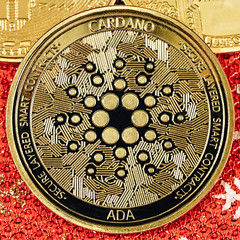
With the recent auction records for physical cryptocoins, images of similar pieces pique my curiosity. One I came across recently was a physical Cardano coin. A web search revealed that these are for sale all over the web, and as far as I can tell these are completely unconnected to actual cryptocurrency - no embedded codes or passkeys like physical bitcoins. Still a fun collectible perhaps, but more on the lines of video game tokens. -Editor
To read the complete article, see:
Cardano [ADA] holders would find themselves happiest as…
(https://ambcrypto.com/cardano-ada-holders-would-find-themselves-happiest-as/)
2022 ANA CONVENTION DIARY
Since I didn't attend this year I don't have my usual Wayne's Numismatic Diary, but thankfully I do have these great reports from Len Augsburger and Pete Smith. Maria Fanning provided images of NBS events. A longer version of Len's report will appear in the future issue of The E-Gobrecht from the Liberty Seated Collectors Club. First up is Len. -Editor
The annual ANA convention is a highlight of the annual numismatic calendar, and the combination of people, coins, and get-togethers is hard to beat. Preparation always starts early for me, and I build a detailed spreadsheet to keep track of everything.
Literature Dealers
Charles Davis was set up with his usual array of significant numismatic literature. Kolbe & Fanning were
at the show but could not commit to setting up as it was unclear, until the last minute, when they would
have to take their son (who is starting the University of Cincinnati) to school. As it turns out they were
able to come to the ANA but did not bring inventory. From Charlie I purchased a copy of the 1992 M. N.
Daycius circular that promoted a bogus sale of numismatic literature, in addition to a nicely bound copy
of the Breen/Gillio work on fractional gold pieces.
Rittenhouse Medal
By Wednesday the Liberty Seated Collectors Club table was a beehive of activity. John Frost had brought
for exhibit a group of medals from the Charles Barber estate. My favorite was the MT-1, featuring a bust
of David Rittenhouse, engraved by William Barber. The American Philosophical Society has an 1871
letter of transmittal from Barber, presenting them an MT-1 Rittenhouse medal that was patterned after
a Rittenhouse bust in their collection. Later in the week John Lundsten exhibited his nearly complete set
of Seated dollars at the LSCC table. Among the visitors to the LSCC table was Tom Bender, who was
presented with the 1870-S half dime table skirt printed for the 2019 Seated Fest II exhibit in Baltimore.
Club Meetings and Speaker Presentations
On Wednesday I attended the JRCS meeting, which featured a great presentation by Barry Sunshine and
Chuck Link. Chuck Link's collection of the proof coins in the Bust series was fascinating.
John Dannreuther's forthcoming volume on
proof silver coinage will no doubt bring clarity to this tricky area of collecting, and I suspect the Link
collection as a whole will enable further insights.
Club meetings and speaker presentations dominate Thursday and Friday at the ANA convention. The LSCC met promptly at 9am on Thursday and featured a talk by Bob Evans on silver coins recovered from the SS Central America. The ever-energetic Brad Karoleff extracted over $3,000 in an auction fundraiser, which featured a selection of coin glass and back issues of the Gobrecht Journal. We also auctioned a two-volume set illustrating Seated quarters from the Gene Gardner collection. Gardner issued these books in small numbers and privately distributed them at the time of printing. A big thank you to all the winning bidders, and also to those who donated material for auction.
NBS Symposium and the Smithsonian
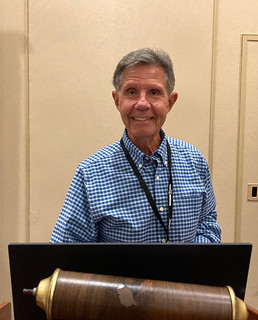 The Numismatic Bibliomania Society (NBS) Symposium on Thursday featured Chuck Heck
speaking about the
The Numismatic Bibliomania Society (NBS) Symposium on Thursday featured Chuck Heck
speaking about the making of
his current publication on 1794 large cent die states. Two of Chuck's
grandchildren got to see their grandfather walk the audience through the process of self-publishing.
Chuck had books for sale at the show, and I was happy to bring a copy home. Another EACer, Harry
Salyards, was pre-selling his forthcoming book on early dollars, and had a draft available for viewing. I
promptly ordered a copy, and it will be a pleasant surprise when it shows up in the mailbox this fall.
Regarding other books, David Alexander is working on a volume on Napoleonic medals and brought a
draft to the show.
On Thursday I also attended an event for the Smithsonian, where they presented their latest exhibit, Really Big Money, at the National Museum of American History. The foot traffic they get in the museum is extraordinary, with literally thousands of people walking through the numismatic exhibits every day. There really is no other single entity, except perhaps the U.S. Mint, that generates this level of public exposure to numismatics. It's a worthy cause, and, if you wish to donate, it would be money well spent.
NBS General Meeting
The NBS meeting was held on Friday and featured a video presentation of the Joel Orosz library. I had
visited Joel on July 14, with Lianna Spurrier, who produced the video. This video covered various aspects
of the library including antebellum references related to numismatics, numismatic association items, the
NBS archives, and of course recent purchases. Joel recently acquired the McAllister memorandum (one
of three copies known, of which this is the only example currently traced), which recorded John
McAllister's recollections after speaking with (former Chief Coiner) Adam Eckfeldt at the U.S. Mint in
1844.
The NBS had a most successful fundraising auction, held as usual at the beginning of the meeting, courtesy of many donors and bidders. David Fanning produced the sale catalog and called the sale, which raised $10,890 on behalf of the club. This is an unaudited figure based on my (usually faulty) arithmetic. Our capable Treasurer Chuck Heck has received all the related paperwork and will be challenged to bring order to the chaos!
Building a Numismatic Library
On Friday afternoon I delivered a Money Talks presentation, Building a Numismatic Library for Pleasure
and Profit. I'm more driven by collecting books for research purposes, but part of the collector mentality
always likes to make a buck, and I shared a few ideas in that regard. A number of bibliophiles were in
attendance and the ANA will be releasing the video in due course.
Newman Numismatic Portal
Throughout the week a number of people approached me about potential contributions to the Newman
Numismatic Portal, in addition to directly loaning material at the show. Among the contributors were
Eric Schena, Paul Hybert, and Bill Shamhart. Paul has been supplying us with congressional reports
related to the U.S. Mint for a long time and still manages to find things we do not yet have. This week he
loaned an 1830s document related to Continental Currency that I am looking forward to digesting. I also
met Michael Bourne for the first time, who had earlier forwarded important material on auction
appearances of U.S. pattern coins from the pre-Internet era.
Rittenhouse Society
The ANA convention always wraps up for me with the Rittenhouse Society breakfast on Saturday
morning. This is capably hosted by Whitman Publishing every year and their sponsorship is most
welcome. This group brings together authors and researchers and represents a great networking
opportunity to see how we can all help each other to push forward numismatic science. I was especially
pleased to see founding member Ken Bressett in attendance. He is well into his 90s but seems to have
just as much energy as when I first met him many years ago. All in all, it was a great week, and I can't
imagine a better way to wrap it up than by spending a few minutes with Mr. Red Book himself.
Pete Smith submitted these notes. -Editor
Hundred Year Numismatist
At the ANA 131 st Anniversary Banquet on Friday, August 19, 2022, it was announced that Kay
Edgerton Lenker would receive the Elvira Clain Stefanelli Memorial Award for Achievement in
Numismatics. Lenker was not present to receive the award.
The printed program stated that she was age 22 in 1944. The announcer stated that she was 100 years old. This would add her to the list of hundred-year-old numismatists.
My records indicate that she was born in Philadelphia on November 29, 1922. If that is correct, she is still a few months short of achieving that distinction.
Mint Director at ANA
I was pleased to get her left-handed autograph on a card she provided.
That's better than a left-handed compliment! Thanks, everyone! -Editor
BLONDEAU'S COMMONWEALTH PATTERNS
In an email to clients earlier today, dealer Allan Davisson wrote about the Commonwealth pattern coinage of Peter Blondeau, illustrated by a piece in his firm's upcoming sale. It is republished here with permission. Thank you. The auction closes Wednesday, August 31st 2022. -Editor
Peter (Pierre) Blondeau was brought to London to improve the coinage of the Commonwealth. First minted in 1649, it was a coinage by committee
with a design that expressed a puritan dislike for anything ornamental. Realistic portraits, ornate shields, and Latin inscriptions gave way to a coin with a simple shield on the obverse—St. George's cross, a repeat of the shield along with an Irish shield on the reverse, and a simple legend in English to replace the Latin phrases of the Stuart coins. It was produced under Thomas Simon, Master of the Mint, who probably was not particularly happy with it, a view widely shared by the public. No one knows who actually designed the coin.
It wasn't the design that was of concern on the part of the Council of State and the House of Commons. Counterfeiting and clipping were the immediate concerns and Blondeau was already known for work he had done for the Irish mint in 1654 and 1655 and his milling techniques—improved machinery for striking money.
This mechanical striking of coins provided edges that defied clipping as well as coins having a beautiful polish.
Cost of production was not an issue. Blondeau offered to coin for the very self-same price
as the Mint incurred with the traditional hammering of coins.
Convincing the Council was not Blondeau's chief problem. The moneyers at the Mint were just as resistant to Blondeau's coining mill as had been the workers several decades earlier when Mestrelle had brought a milling machine to the coinage of Elizabeth I and struck six pences dated from 1561 to 1571. Their resistance was fierce and, ultimately, as effective as it had been earlier. One important distinction: Mestrelle was ultimately convicted of forgery. Blondeau was celebrated as a man of respectable position.
He also was never paid for his work and expenses incurred over four years of trying to satisfy the Commonwealth officials. (Oliver Cromwell, however, did use and pay him and granted him a pension of £100 per year. Thomas Simon used his dies to mint the Cromwell coins of 1656 to 1658).
Blondeau made about three hundred silver pieces—patterns—at his own expense. Apparently Thomas Simon was the engraver. His skill shows in the perfection of the work and such fine touches as the frosting of the St. George's cross.
Blondeau reported that he had made some gold pieces but none are now known. One document reports that he made his patterns in a private house in the Strand, doubtless in order to prevent the Mint officers from discovering his secrets.
He minted two halfcrowns that differ by edge lettering. His shilling and his sixpence have edges milled with straight lines.
With only 300 examples across all denominations, the Blondeau patterns are all rare. A few escaped into circulation. Despite the rigors of handling and whatever else time can do to an unprotected bit of silver coinage, even a piece we now call Very Fine
demonstrates the exceptional quality of Blondeau's work—even appearing design still in strong relief, a fully intact edge, and surfaces that still express the skill that Simon brought to using Blondeau's exceptional minting techniques.
(A detailed account of Blondeau's work for the Mint along with copies of documents at the time is available in Henfrey's Numismata Cromwelliana published in London in 1877.)
For more information, see:
https://davcoin.com/
THE WILDMEN
Bob Knepper's collection of wildman
coins is being offered by Stack's Bowers beginning this week. Jeremy Bostwick wrote a short article on them for the SBG blog.
-Editor
One of the more popular collecting aspects within world coins, and especially within German coins, is the wildman
motif often associated with the Duchy of Brunswick-Luneburg and its various subdivisions. A 1916 article in The Numismatist by Moritz Wormser relates that the wildman …is a descendant of the Greek Satyr and the Roman Faun.
Owing to the duchy's location among the Harz Mountains, and the mountains' rich deposits of silver (among other metals), the idea of the wildman was meant to evoke fear among those who steal from the mines. In this sense, the wildman had a role in folklore as a local protector, and even made his way into the coats-of-arms of the various towns within the area.
Extending this iconography to numismatics, the wildman figures very prominently in the coins from the duchy, with the multiple talers presenting an even more impressive canvas on which to convey this folklore. Usually encountered heavily bearded and nearly nude (save for foliage-based loin coverings and sometimes a corresponding crown), he tends to be rather muscular, though varying engraving styles offer a range of depictions that add to the collecting intrigue for both seasoned collector and novice.
Our upcoming Global Showcase Auction later this month will present the first installment of the Robert C. Knepper Collection—an advanced collection of these vast wildmen types from all around the realm of the Duchy of Brunswick-Lunerburg, as well as some other areas. Featuring high grade examples assembled over numerous decades, some particular standouts include a nearly-Choice issue from the reign of Heinrich Julius, another from the reign of Friedrich Ulrich, a houseboy
Taler issued under August the Younger
, a colorful near-Gem Taler from Johann Friedrich, and a wonderous multiple Taler struck during the reign of Christian Ludwig. Look for these exciting specimens, along with the rest of the Knepper Collection in Session A of our Summer Global Showcase Auction, selling on August 22, 2022!
Here are a few selections from the sale. -Editor
To read the complete article, see:
THE WILDMEN AND THE ROBERT C. KNEPPER COLLECTION
(https://stacksbowers.com/the-wildmen-and-the-robert-c-knepper-collection/)
View all items from the Knepper Collection, see:
Selections from the Augustana & Robert C. Knepper Collections - Lots 30001-30760
36 LOTS
(https://auctions.stacksbowers.com/lots?
sort=auction_date_lot_number_asc&search=From+the+Robert+C.
+Knepper+Collection&limit=36&lots_range=upcoming)
CANADA'S NEW OSCAR PETERSON COIN
This CBC article describes Canada's new commemorative coins for jazz musician Oscar Peterson. -Editor
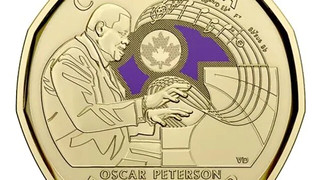 Montreal pianist and jazz musician Oscar Peterson is being honoured with a commemorative coin, released today.
Montreal pianist and jazz musician Oscar Peterson is being honoured with a commemorative coin, released today.
Peterson, who died in 2007, was one of Canada's most decorated musicians and is remembered as one of the greatest jazz pianists of all time.
The Royal Canadian Mint is issuing the $1 commemorative circulation coin to honour Peterson's "extraordinary talent and enduring musical legacy," it said in a statement.
"The whole city will finally realize that yes, we had the greatest pianist in the world, living here, in this country. And I'm so very, very proud that he was my friend," said Oliver Jones, a collaborator and close friend.
Raised in Montreal's Saint-Henri neighbourhood, Peterson got his start by playing for the predominantly immigrant and Black communities of the city's south side. Though Peterson rose to international acclaim in the span of a few years, he always maintained a connection to local talent and Canadian artistry.
The coin features Peterson playing the piano and musical notes corresponding to his 1962 composition Hymn to Freedom, which became an anthem for the civil rights movement in the 1960s.
There is also silver $20 coin that is available through the mint.
Peterson passed away in 2007 after a career of more than 60 years. He is remembered as a technical genius of jazz, deserving of his place among the greats.
Kelly Peterson, widow of Oscar Peterson, at the unveiling of the new commemorative coin.
To read the complete article, see:
Canada's newest coin pays tribute to Oscar Peterson
(https://www.cbc.ca/news/canada/montreal/oscar-peterson-commemorative-coin-1.6547499)
The Royal Canadian Mint Press Release has a photo from the launch ceremony and information on the coins and their designer. -Editor
The Oscar Peterson commemorative circulation coin was designed by artist Valentine De Landro, an accomplished comic book artist, illustrator, and designer from Ajax, Ontario. His design features Oscar Peterson at the piano, with his hands in full motion, from which emerges a flowing musical scale showing two closing bars of his famous Hymn to Freedom. Mr. Peterson's name completes the design.
The Oscar Peterson circulation coin is limited to a mintage of three million coins, of which two million feature a purple accent, Oscar Peterson's favourite colour. It will reach Canadians through their change as bank branches and businesses replenish their inventories of $1 circulation coins.
The coloured and uncoloured circulation coin can be purchased together as part of a six-piece Collector Keepsake coin set. They are packaged in a richly illustrated collector card that contains one of each currently circulating coin, from five cents to two dollars. Other collector products adding to the celebration of Oscar Peterson's legacy include special wrap rolls of 25 one-dollar circulation coins, in coloured and uncoloured versions, as well as 1 oz. fine silver and pure gold versions of the circulation coin design.
To read the complete Press Release, see:
ROYAL CANADIAN MINT HONOURS LEGENDARY CANADIAN PIANIST AND JAZZ GIANT OSCAR PETERSON ON NEW $1 CIRCULATION COIN
(https://www.newswire.ca/news-releases/royal-canadian-mint-honours-legendary-canadian-pianist-and-jazz-giant-oscar-peterson-on-new-1-circulation-coin-800961927.html)
CANADIAN COIN FEATURES METIS BEADWORK
A World Mint News Blog article by Michael Alexander discusses the newest coin in the Royal Canadian Mint's series on Indigenous Canadian art. -Editor
The Royal Canadian Mint has released the second coin in the series entitled Generations,
which focuses on Indigenous Canadian art. An additional element of the series celebrates the passing on of traditional knowledge from one generation to the next, preserving overall Indigenous culture and heritage through art as well as the spoken word. The latest coin features the artwork of the Red River Métis and the tradition of their beadwork, which is a distinct and unique expression of Métis culture and identity, and an exercise in visual storytelling.
The coin's reverse engraving is created in an elaborate style that perfectly replicates traditional Métis beading. In lieu of colour, varying relief height and frostings help create a striking contrast that sets neighbouring elements apart while adding depth to the overall design. The inscriptions feature text in the Metis language, TAAPWEEYIMISHO (Believe in yourself
) and TAAPWEEYIMIK LII MICHIF (Believe in the Metis
), which are shown below the primary design and applied on ribbon streamers. Further below is the text LA RIVYEER ROOZH (The Red River
). Above the design is the text CANADA 2022 with the artist's initials JK placed to the right side near the edge. The obverse includes an effigy of HM Queen Elizabeth II and the denomination of 20 DOLLARS, which is placed below the Queen's likeness.
To read the complete article, see:
Canada: Second silver Proof coin in Generations
series features indigenous Metis beadwork
(https://world.mintnewsblog.com/2022/08/canada-second-silver-proof-coin-in-generations-series-features-indigenous-metis-beadwork/)
The coin's designer Jennine Krauchi is profiles in an article on Windspeaker.com, the website of the Aboriginal Multi-Media Society of Alberta (AMMSA). -Editor
From the time Jennine Krauchi was a very young girl, she was always around beadwork. Her father sewed jackets, vests, moccasins, mukluks and other items of clothing, while her mother added beadwork designs to the garments.
We lived really close to Sioux Valley, so I remember the women there coming into my mom and dad's shop and doing beadwork. But it wasn't until around ‘93, when I moved from Brandon to Winnipeg, that I really got back into my roots and got back to my culture.
At that time Krauchi met Lorraine Freeman, founder of the Métis Resource Centre, who was looking for a Métis beader to demonstrate beading and teach classes.
And I thought, ‘Well, I'll give it a try', because I knew how to do it and I was Métis. She wanted to get all of these Métis cultural things back and have a rebirth of our culture. And it started from there. At that time [in Winnipeg], you would've been lucky to have enough Métis beaders to sit around a kitchen table.
This month, Krauchi's design for a new coin for the Canadian Mint was unveiled. The reverse of the 2022 $20 fine silver coin, called Generations: The Red River Métis, has her design engraved on it, which includes elements of the Michif language.
La Rivyeer Roozh, meaning the Red River, is inscribed at the base of the design, above which roots represent the Red River Métis homeland and ancestry. From the infinity symbol, which speaks to the Métis Nation's eternal and unbreakable spirit, flows two bands that represent the Red River. They contain the words Taapweeyimisho and Taapweeyimik lii Michif, for "Believe in yourself" and "Believe in (the) Métis".
The fire in the centre of the design speaks to a period of repression and loss, but the Prairie Rose—a classic Red River Métis motif—represents the survival and cultural resurgence of the Nation. Long stems are characteristically adorned with two or three bead accents known as "mouse tracks", while leaves and flower buds fill the pattern with a sense of love and joy.
When I found out that I'd won the competition, it was September 9, 2021,
Krauchi recalls. So it's been almost a year that all of this took place. And almost a year that I had to keep it secret. I couldn't really tell anybody, and it was really hard at times. It was so exciting to think that our Métis beadwork is going to be on a coin.
Krauchi says when she saw the first drawings and engravings, she was absolutely amazed that they had put what looked like little beads all over that coin.
I so want to take it out of the case and touch it because when you see people's beadwork you just want to touch it.
But Krauchi isn't resting on her laurels. She says she's excited to move on to new projects and help keep expanding the scope of Métis beadwork across Canada.
I would say in the last 10, 15 years at the most, the beadwork has just exploded. Now there's beadwork symposiums and you can fill up auditoriums now with bead workers.
To read the complete article, see:
Métis artist returned to a life of beading and now has her work on a new coin
(https://windspeaker.com/news/windspeaker-news/metis-artist-returned-life-beading-and-now-has-her-work-new-coin)
THE BOOK BAZARRE
GEORGE LESLIE, KING OF BANK ROBBERS
The 2009 book King of Heists: The Sensational Bank Robbery of 1878 That Shocked America provided background for this new article on the amazing career of George Leslie, a self-made James Bond of thieves who hobnobbed with high society while carrying out the greatest bank robberies of the era. See the book for the full "absorbing tale of greed, sex, crime, betrayal, and murder," as the Amazon blurb states. Here's an excerpt from the extensive article. -Editor
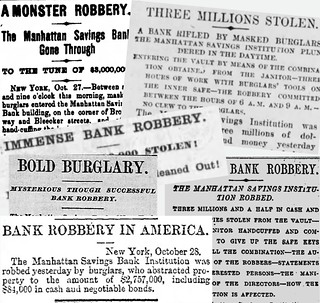 George Leonidas Leslie led a double life: By day, he was a distinguished architect who hobnobbed with New York City's elite denizens; by night, he was one of history's most prolific bank robbers.
George Leonidas Leslie led a double life: By day, he was a distinguished architect who hobnobbed with New York City's elite denizens; by night, he was one of history's most prolific bank robbers.
Unlike other heisters of his time, Leslie's approach was academic rather than brutish. He studied the anatomy of locks, drafted up blueprints of banks, and invented mechanical safe-breaking devices.
During his career,
authorities estimated that his exploits accounted for 80% of all bank robberies in the entire US during his active years of 1869-78.
Altogether, he stole at least $7m ($200m in today's money), much of it pilfered from the bank vaults of America's wealthiest titans.
He took up residence at the prestigious Fifth Avenue Hotel — a gathering place for the ultra-elite of the Gilded Age, including shipping and railroad tycoon Cornelius Vanderbilt and then-president Ulysses S. Grant.
Though he wasn't a millionaire himself, Leslie ingratiated himself into the high-status world, donning the finest suits, attending theater openings, and collecting rare books.
His apparent wealth and pedigree gained him the friendship of robber barons like Jim Fisk (a millionaire who cornered the gold market and orchestrated Black Friday), Jay Gould (a railroad magnate), and Boss
Tweed (a corrupt politician who embezzled millions from taxpayers).
These men, and other members of high society, saw Leslie as a bon vivant of the highest order and accepted him with open arms.
But Leslie had an ulterior motive.
Robbing banks wasn't exactly the kind of profession one could learn from books. It required a strong connection to the criminal underworld. And he found just that in a woman named Fredericka Marm
Mandelbaum.
Mandelbaum was New York's greatest fencer.
Working with an expansive band of criminals and pickpockets across the city, she housed and resold millions of dollars of stolen goods — largely with impunity. Like Leslie, she was in
with the elites, whom she hosted at extravagant parties in a home appointed with ill-gotten luxuries.
Introduced through Fisk, Leslie and Mandelbaum hit it off in grand fashion.
Leslie selected his first target — Ocean National Bank in New York City — and began a laborious, three-month-long planning process.
In June 1869, Leslie made his move.
First, the planted employee let him in at night, after the guards had gone, and he installed his little joker device, a tiny tin wheel with a metal wire around it that went behind the combination knob of the vault's lock.
When the tellers used the vault the next day, the little joker, hidden behind the dial, would get etched with deep cuts where the three numbers of the code were, limiting the combination to just a few possibilities.
Several nights later, Leslie and his crew entered the bank again, removed the little joker, and used the etches to crack the lock.
This only gained them entry through the first door: The safe had three of them, each built of thick iron. And inside the vault the safes had to be opened, too.
For this, the crew relied on a bevy of ingenious
tools — jimmies, wedges, sledges, nippers, and drills.
The following morning, bank officials arrived at a chaotic scene: floors strewn with coins, bank notes, and drill bits. But the main door to the vault was intact, which stumped investigating police officers.
The New York Herald declared it a masterful bank job pulled off by one very special bank robber.
A report in The New York Times remarked that a robbery of this type was a thing never heard of before.
In sum, Leslie and his crew made off with $768,879.74 (~$27.5m today) — a record-setting sum.
And that was just the beginning.
For more information on the book, see:
King of Heists: The Sensational Bank Robbery of 1878 That Shocked America
(https://www.amazon.com/King-Heists-Sensational-Robbery-Shocked/dp/1599215381/ref=sr_1_1)
To read the complete article, see:
The architect who became the king of bank robberies
(https://thehustle.co/the-architect-who-became-the-king-of-bank-robberies/)
FAUX WHAT IT'S WORTH
Loved that headline, and wished I'd thought of it: "Faux what it's worth." This article discusses a seizure of counterfeit currency in South Africa. -Editor
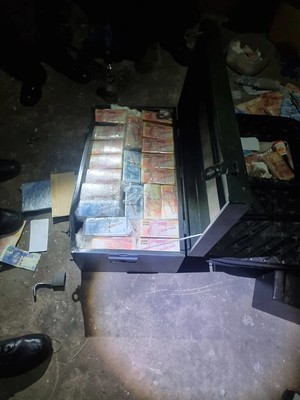 The Tshwane metro police confiscated counterfeit money with a face value of R3.5 million during an operation in Pretoria on Friday.
The Tshwane metro police confiscated counterfeit money with a face value of R3.5 million during an operation in Pretoria on Friday.
The operation was part of an investigation into a syndicate involved in money laundering and counterfeit money.
During the operation, officers followed a convoy of vehicles, including a red Range Rover, two Mercedes-Benzes and a Toyota Corolla, said Tshwane metro police spokesperson, Senior Superintendent Isaac Mahamba.
They stopped and searched the Range Rover in Arcadia Street and found a counterfeit R100 note.
After questioning the driver, he led officers to a property in Stanza Bopape Street, where they found a "steel box full of counterfeit money" and chemicals used to clean the money, said Mahamba.
"The officers also discovered that the name of the suspect matched a suspect who was sought for money laundering," he said.
To read the complete article, see:
PICS | Faux what it's worth: Tshwane metro police confiscate R3.5m in counterfeit money
(https://www.news24.com/news24/southafrica/news/pics-faux-what-its-worth-tshwane-metro-police-confiscate-r35m-in-counterfeit-money-20220815)
REAL AND FAKE COIN-PUSHER VIDEOS
Apparently, coin-pushing machines and coin-pushing videos are a big thing. Who knew? Not me. -Editor
I decided to do something ridiculous that cost a whole bunch of money. So I bought a coin pusher.
Coin pushers are amusement games filled with coins and sometimes prizes (including cash). Players drop coins of their own into the machine and onto a platform that constantly moves backward and forward. The aim is to set off a chain reaction that will push coins or prizes off a second, stationary platform and into a payout tray below. Although the machines are legal under federal law, coin pushers that offer cash prizes are outlawed in a number of states.
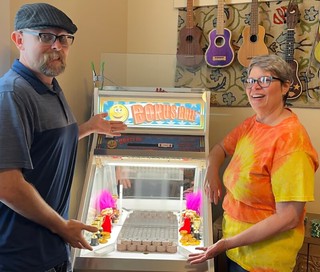 Owning their own coin pusher, of course, meant John and Cheri had to stock it themselves. And winning their own money over and over again got boring quickly. So in August 2020, the couple decided to launch a YouTube channel to make their new hobby more exciting. That channel — We Play You Win, which has more than 11,000 subscribers — is one of many in YouTube's coin-pushing niche, which can attract millions of views each week.
Owning their own coin pusher, of course, meant John and Cheri had to stock it themselves. And winning their own money over and over again got boring quickly. So in August 2020, the couple decided to launch a YouTube channel to make their new hobby more exciting. That channel — We Play You Win, which has more than 11,000 subscribers — is one of many in YouTube's coin-pushing niche, which can attract millions of views each week.
Some vloggers in the space tout huge buy-ins,
the amount one supposedly needs to put in to play high-reward machines, and even bigger wins. For instance, there's this credulity-straining video, which purportedly shows the creator winning $10.8 million on a $2 million buy-in machine.
John and Cheri's channel is far more humble and far more believable: They do not claim to be winning big. We said, ‘No, we're going to do something different,'
says John, a 40-year-old software engineer who has since found a new job in his field. Instead, they make their live streams interactive, offering small prizes like whoopee cushions to viewers who correctly predict the end results of their games.
Cheri says she's irked when she sees people gravitating toward coin-pusher videos advertising things like a $500,000 Buy in!
and TOTAL PROFIT.
You want to tell them, ‘Look, the emperor has no clothes,
she says. They're just scamming you. Don't go over there!'
Critics allege that a number of popular coin-pushing vloggers are in fact operating out of their own homes, using their own coin pushers — without revealing the truth to their audiences. These creators will in turn ask their followers to fund their gambling
by donating to them on YouTube live streams or by joining their Patreons.
It ruins it for people who are trying to be honest,
says Matt Magnone, a 35-year-old full-time arcade vlogger from Pennsylvania who has three million followers across his YouTube and TikTok channels. You get these few bad apples who stage things, and then when the rest of us win prizes legitimately, we get questioned for it.
Although the coin-pushing vloggers Input spoke to are reluctant to name names, mostly because they don't want to get swept up in petty YouTube drama, they say that bad actors are easy to suss out. The way that you can spot that someone's fake, other than if they claim to operate in a state where it is clearly illegal, is the noise,
says Cheri. Videos by coin pushers like Dalton's Garage and A&V Coin Pusher both share strikingly similar background noises, which appear to be a loop of generic casino sounds.
Another sign that something is amiss, says Cheri, is when vloggers don't show winnings actually coming out of the machine.
Ultimately, the couple just want people to know that much of what they're watching isn't real, so they don't end up being separated from their money by scammers. If there were really places where you could play these magical [high-reward] coin pushers, it would be mobbed. There'd be information all over Reddit — but there isn't any,
says John. The internet doesn't keep secrets, you know? It just doesn't.
To read the complete article, see:
YouTube coin-pusher videos are huge. But what's real and what's fake?
(https://www.inputmag.com/culture/coin-pusher-machine-youtube-videos-fakes-scams)
FEATURED WEBSITE: ANCIENT COIN CLUB OF LOS ANGELES
This week's Featured Web Site is the Ancient Coin Club of Los Angeles (ACCLA).
The Ancient Coin Club of Los Angeles (ACCLA) was established in 1966 to advance the knowledge and study of ancient numismatics, ancient coins, and their history.
ACCLA members include people who are interested in ancient history and numismatics, ancient coin collectors, and some experienced numismatists with an extensive knowledge of the field. ACCLA members have had articles published in journals such as the Celator, and some member's coins have been featured as plate coins in important numismatic publications including David Sear's recent editions of Roman Coins and Their Values.

